|
To Mexico City
End of Idleness, Back to Toil
In Guadalajara, I explored all the attractive, and even the unattractive sites as recommended by the guidebook, for the lack of other suggestions. In my case, the latter was Agua Azul Park, where in the huge “House of the Butterflies" I did not see a single wing, while outside there were many. I had a similar lack of success in the famous "Orchid House", their time would only be as late as October.
I was quite happy when I could start out on the winding road to Mexico City in freshly washed and perfumed cycling clothes – thanks to a local laundry and 50 pesos. Anyway, probably due to my incipient senility or due to the two-day cleansing of the brain by nutritional drinks, I had forgotten the USB flash drive, on which I continuously backed up data, in the shorts left at the laundry. Good news, the flash drive survived the washing, drying and ironing without any damage, not a bit was lost from the 16 GB.
It is about 550 kilometers on the highway from Guadalajara to Mexico City, but I was to stretch it out to approximately 800 kilometers across the mountains and valleys. I set out for the largest Mexican lake, Chapala, in the town of the same name. It was difficult cycling out of Guadalajara, heavy traffic, a broken verge, but not to be compared with the mad arrival. Beyond the Airport, the traffic slowed down, but the verge remained, so it became a very comfortable ride, which was not spoilt even by the noticeable headwind.
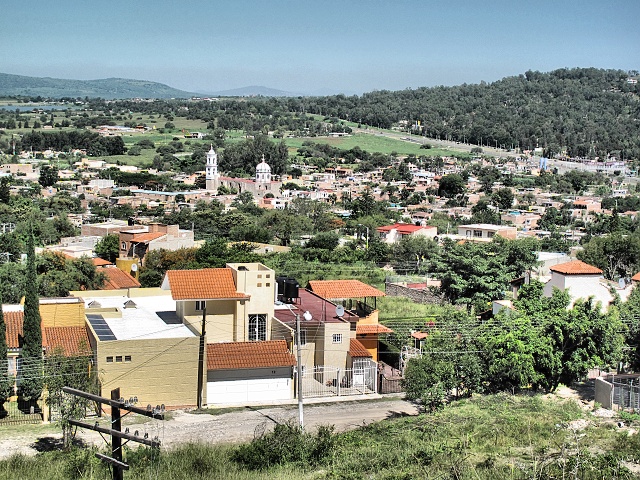
[Ixtlahuacán de los Membrillos] View of the town
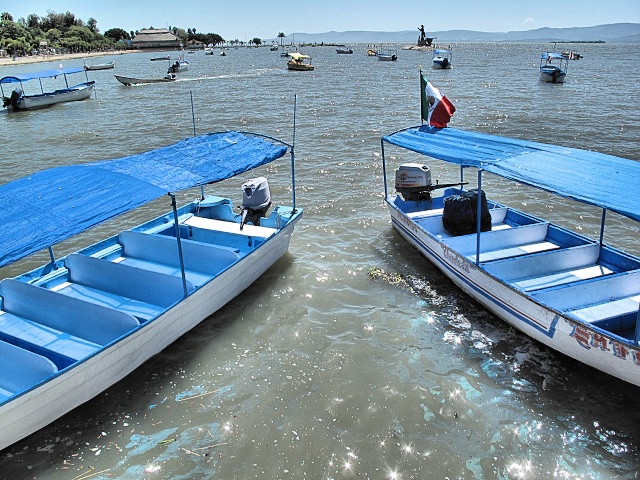
[Chapala] Boat ready for a trip to Scorpion Island; statue in the sea in the background
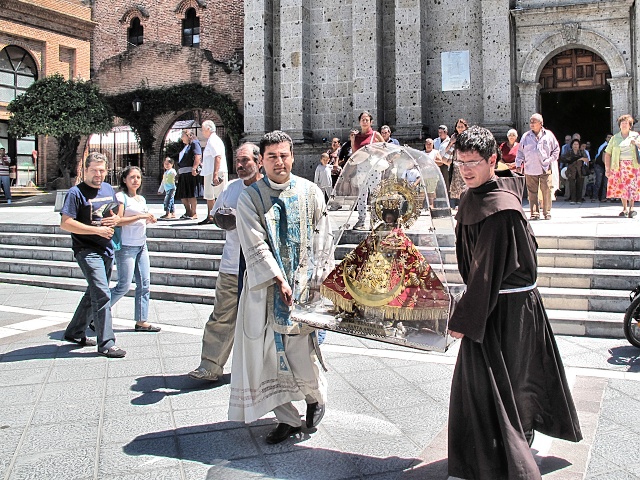
[Chapala] Priests carry the statue of Nuestra Seòora de Santa Anita from the church, accompanied by festive bell ringing
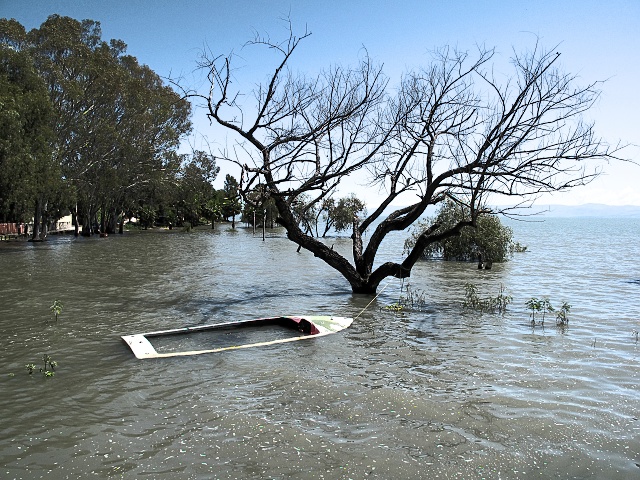
[Ajijic] The water rose unexpectedly, affecting this boat, besides flooding the trees
Wow, a Cycle Track!
And imagine, there was the first Mexican cycle track! After a few hundred meters it deteriorated due to the wind-blown sand, but the asphalt surface would have appeared if someone had swept it a little. Simply, the quality varied greatly, sometimes the path disappeared for a few kilometers, to emerge again later. I was grateful for it, despite all the difficulties. In Jocotepec, which is at the westernmost end of the lake, I tried to find reasonable accommodation. There are no camping sites, which I missed, and sleeping in the wilds in mainland Mexico is not as safe as in Baja. Most of the land is somehow utilized and there are also many vagrants who also spend the night out in the wilds. Even though they were friendly towards me and accepted me as an equal, the question was what they would do if they saw my equipment, expensive to them, under their circumstances.
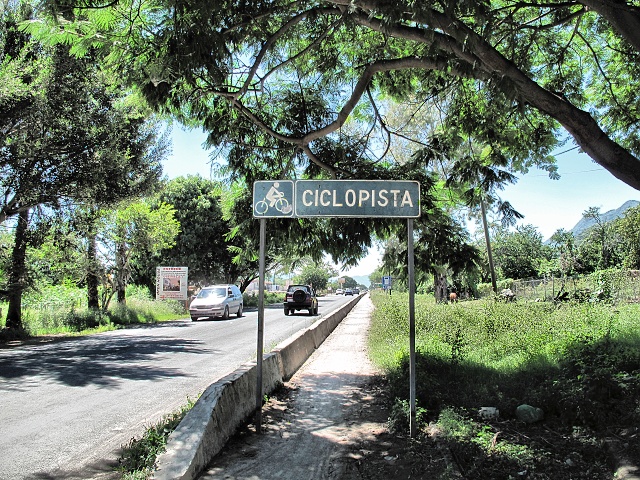
[Ajijic] The first cycle track I saw in Mexico...

[Ajijic] ... after a few hundred meters changed into a sandy path, they simply forgot to sweep the asphalt
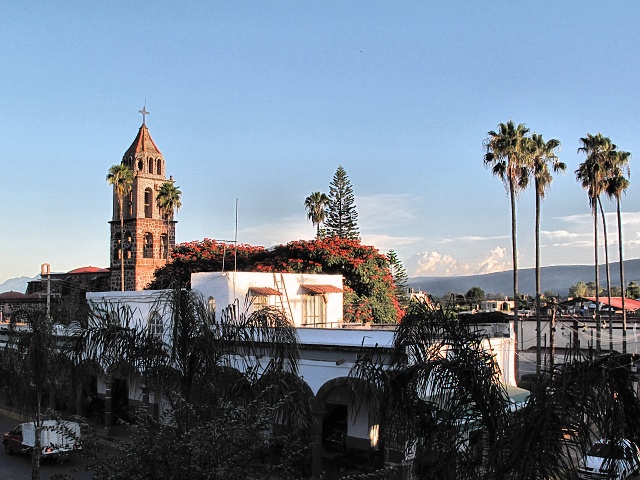
[Jocotepec] I did not have to risk any of the dangers of the road to take this photograph from the window of the pub where I was dining
On the next day, I cycled around Lake Chapala in an easterly direction. Without the headwind it would have been idyllic and I would have considered the final crossing of the ridge to Sahuayo as a diversion. In this manner, I could at least see the towns beside the lake, and the expensive, expansive villas above Lake Chapala. In Sahuayo, I encountered a local cycling enthusiast traveling, however, on a scooter instead of on a bike, and carrying his son aged about eight years in the front. He led me to a reasonable hotel 50 meters from the square and invited me to his musical instrument store. But then I would not have been able to see anything of the town, estimated by me to have about 50,000 inhabitants as I cycled downhill towards it. I tried to explain this to him, gave him my cycling visiting card with a link to this website and hoped that he understood my reasons.
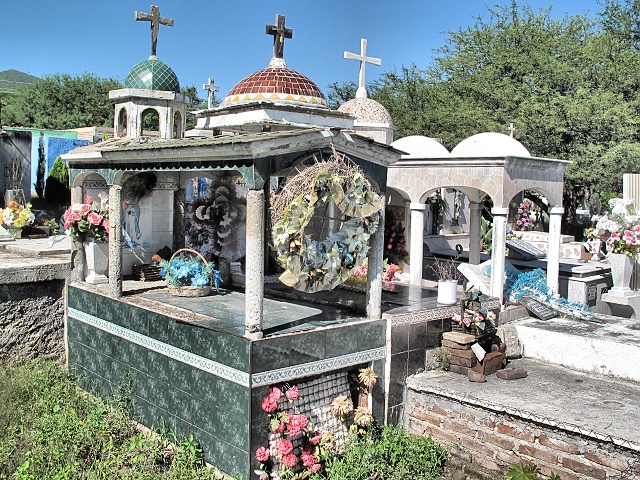
[Tuxcuaca] Mexicans have a liking for cemeteries, even in the smallest villages
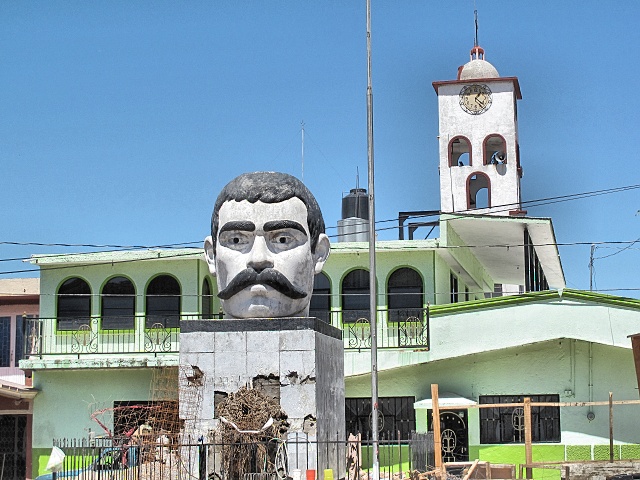
[Villa Emiliano Zapata] A giant bust of Zapata took my interest, in particular for its resemblance to Paleèek, of the Czech singing duo of Paleèek-Janík (or did it rather resemble Janík?)
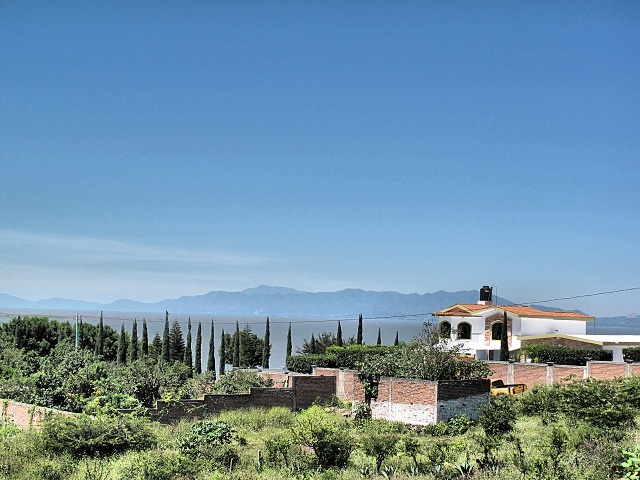
[Villa Emiliano Zapata] Many imposing villas on its shores loom above Lake Chapala

[Petatan] The small town juts out far into Lake Chapala
Sahuayo de Morelos
An insignificant Mexican town, not even worth a mention in the index of a guidebook. Yet it has all the attributes of Mexican cities that are quite different from the lifestyle in our country. The dominant feature of any town is always a Catholic church. Even I, as a practicing atheist, think that the Catholic Church has contributed and continues to contribute to a better life for the Mexicans. Firstly, by the imposing churches, it has provided a certain measure of quality to the architecture and design which ordinary Mexicans can not even attain by accident. But especially, it has given them the authority to hold at bay the passions glowing in the Spanish - Creole - Mestizo - Indian heads. Just stand for a few minutes in front of any church and watch the passers-by. You will not find a man who does not take off his sombrero, cross himself and mutter a prayer there. Not to mention the women. Even passing motorcyclists at least cross themselves (it is not visible what the drivers of cars do).
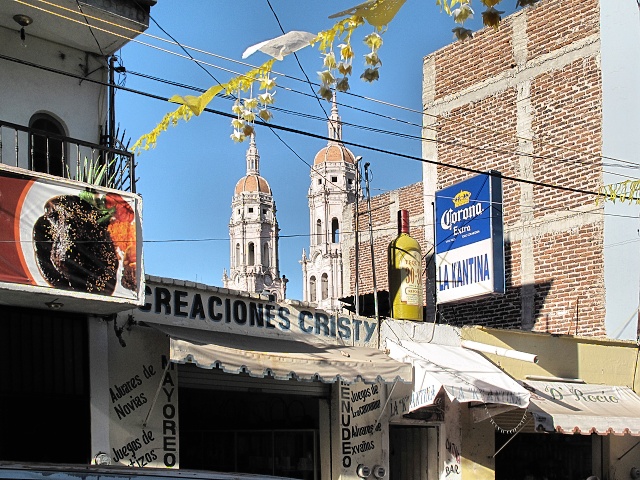
[Sahuayo de Morelos] As in all Mexican cities, here too the church towers above everything else
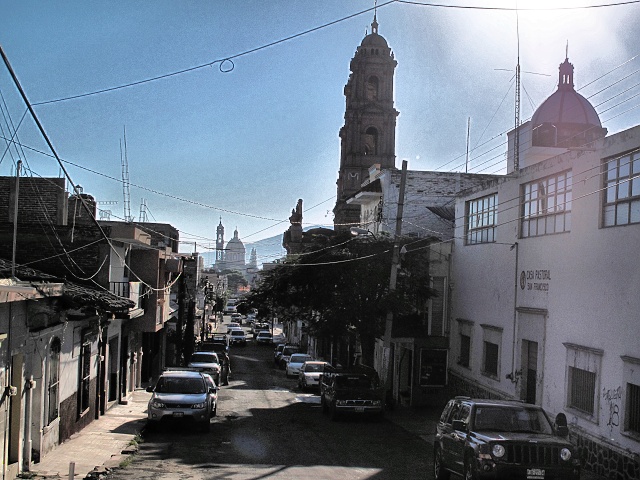
[Jiquilpan de Juarez] The sun came out above the city
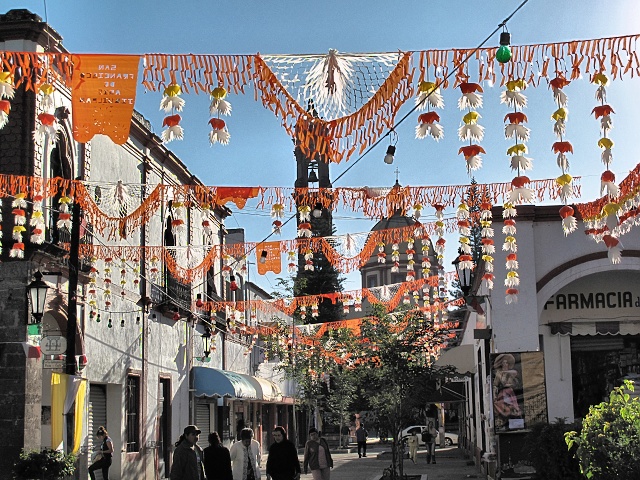
[Jiquilpan de Juarez] You can tell by the colorful decorations that you are in the city center
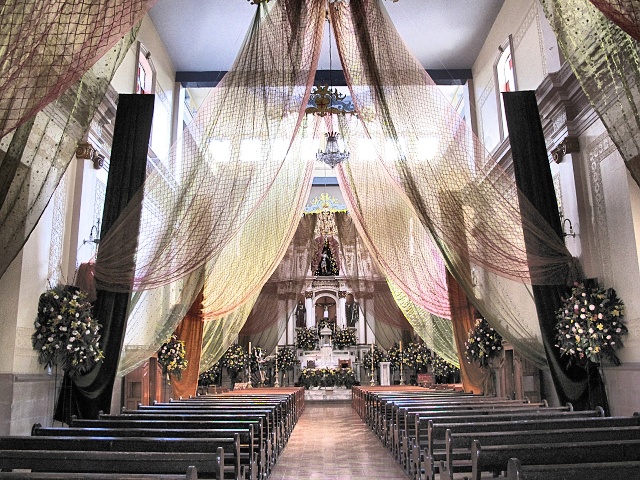
[Villamar] With some wit, even in a poorer village it is possible to decorate the church impressively
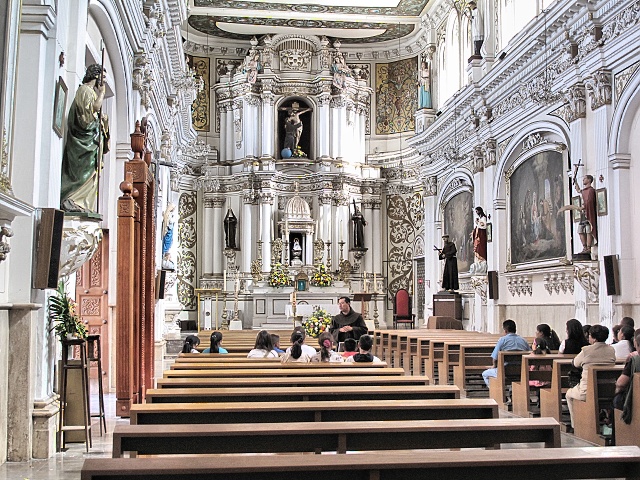
[Zamora] Sunday, or to be exact, Saturday School in the local Cathedral
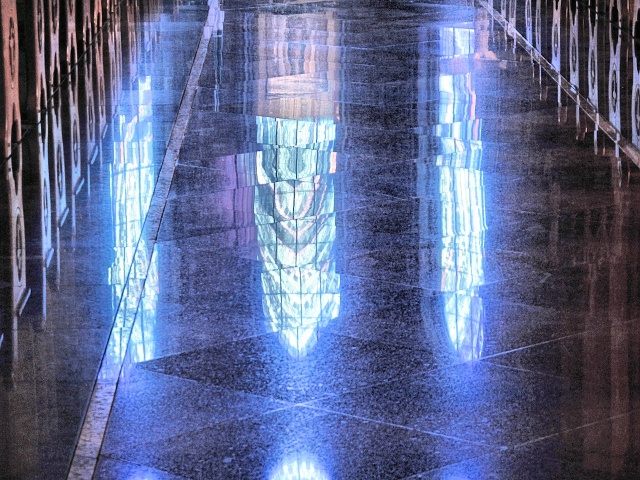
[Zamora] The windows of the cathedral are reflected in the perfectly polished floor
Neighborly solidarity has not disappeared from Mexican life. In the evening, the Square came alive. Entire families, including the obligatory miniature dogs, sat on benches and chatted, only the dogs keeping their mouths shut and not barking. Old women knitting or crocheting did not keep silent for a picosecond, regardless of who was sharing the bench with them. Young people walked hand in hand, proclaiming their developing relationships. Vendors squirmed their way through the bustle, selling balloons on strings and cotton candy, goods in high demand. The local loony in a wheelchair was affably accepted everywhere, although his behavior was greatly out of the social norms. And what really surprised me, the local street merchants were not at all aggressive, as if sales did not really matter. There were also other important things in life, not so?
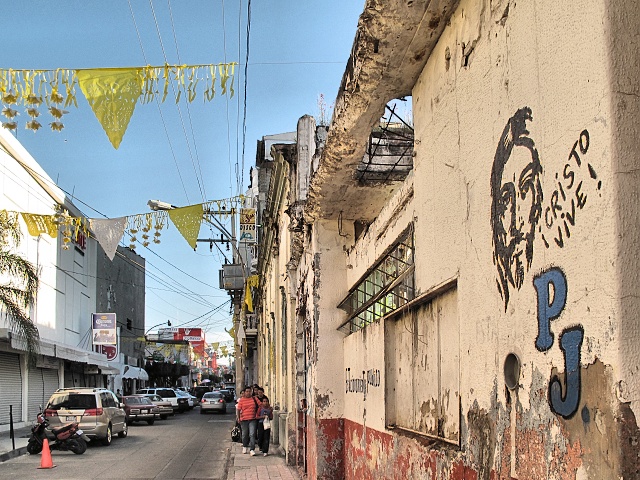
[Sahuayo de Morelos] The true Mexico begins just 100 meters from the square
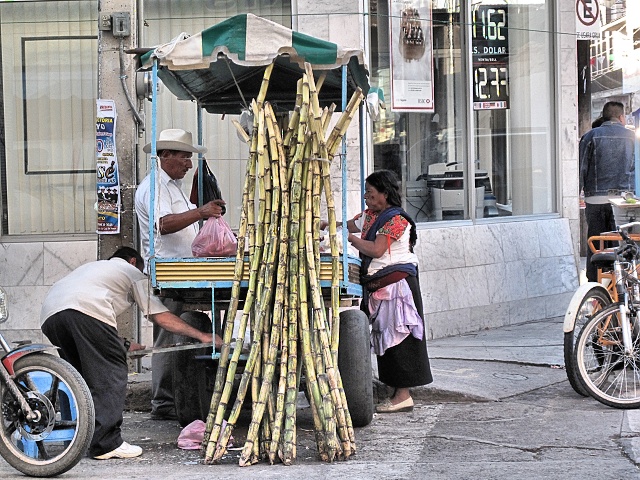
[Sahuayo de Morelos] Sugar cane is grown in the surrounding area, this is how it is sold fresh
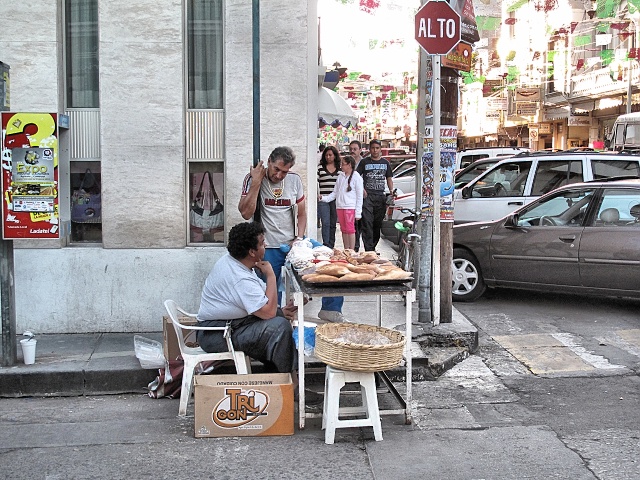
[Sahuayo de Morelos] Bread and bakery products are often sold in the streets, exhaust fumes and dust not spoiling their excellent flavor at all
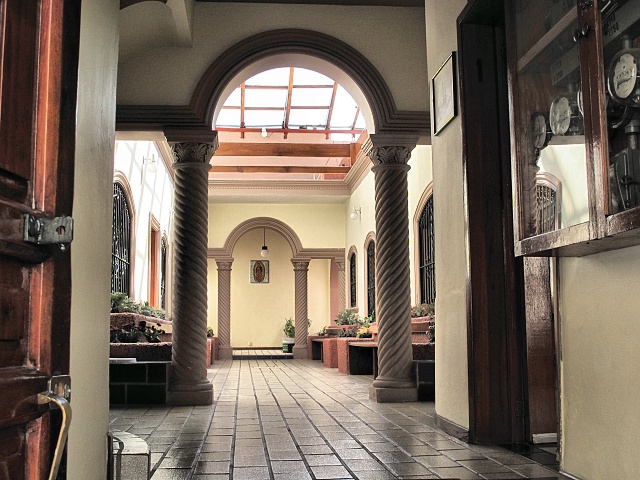
[Zamora] Interior of one of the houses
Child Labor
Children, from an early age, especially in the villages, help their parents. They work on family latifundias, mostly on quite small fields, and then go to market with their parents and help them with the sales. It does not seem to restrict their development. On the contrary, one can see how they enjoy it, and how proud they are that they can somehow interact in adult life. And, in the case of any global trouble, whose children do you think will survive – our spoiled ones who have no idea of the value and origin of money, or those local practically- oriented kids? The only thing they are lacking is a quality education. When they achieve this, they will want a better life for their own children, so that they in turn do not have to help their parents in their childhood. What a shame!
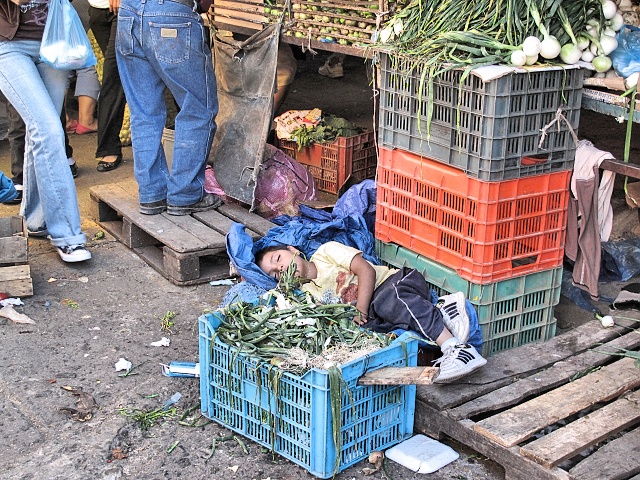
[Zamora] A boy, exhausted from helping his parents in the marketplace, fell asleep among the vegetable crates
Hillocks, Hills, Mountains
I was cycling already at altitudes above 2,000 meters, the terrain was hilly and not giving away anything free to a cyclist. Fortunately, the low gears allow the optimum tempo of 50-60 rpm to be achieved by the legs. So far I had no problems with the altitude. I'd planned the route through a pass at an altitude of 3,000 meters and, if it went smoothly, there were also some 4,000-meter passes ahead. The temperature had dropped but was acceptable. In the morning and on the downhills it was quite cold. I would probably wear a jacket, leggings and my other cycling clothes, which had been through the winds blowing from Alaska through Australia to Japan, and which were not as permeable as those I had been wearing. The old sweater had the advantage that it was so weathered that I looked like a pauper in it. Together with the scratched and rusty bicycle, it discouraged anyone from taking a longing to my property. At least that is what I hoped...
From Zamora I headed off in the direction of Morelia. However, in Carapán I took a sharp right turn-off in the direction of Paracho. At the intersection, I ate two tacos. For the first time I did not enjoy them, as there was too much meat in them (I guessed goat meat) and almost no vegetables. And the woman even wanted 20 pesos for the 2 tacos, claiming there was a lot of meat in them. I cycled through several Indian villages (Purépechas), greatly neglected, with women and girls in colorful traditional clothing, babies strapped on their backs, men in ordinary civilian clothes. I did not photograph them, they mostly did not like to be photographed. Paracho is a small mountain town situated at an altitude of 2,220 meters, famous for the manufacture of stringed instruments, mainly guitars of course. It was quite cold in the morning as I was leaving – 6 degrees. People were wearing thick jackets and gloves. For the first time, I pulled on my leggings and put on a fleece jacket. A long downhill ride was ahead and I would probably have got frost-bite without these. The descent to Uruapan was 20 kilometers, 15 kilometers of which were on a new road with a 1-5-metre wide verge, a total rarity there. The road was properly banked, so I enjoyed the superb freewheel descent, neither pedaling nor braking, merely controlling the angle of the bike around the bends. I felt as if I was skiing.
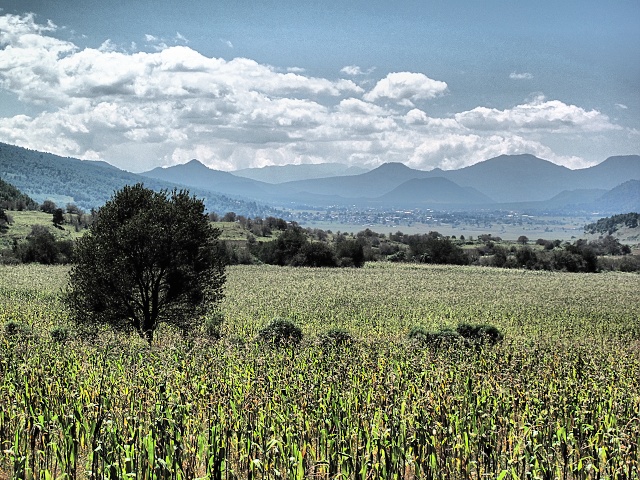
[Near Chorán] Corn thrives at an altitude of over 2,000 meters, and does not even mind the surrounding 3,000-meter peaks
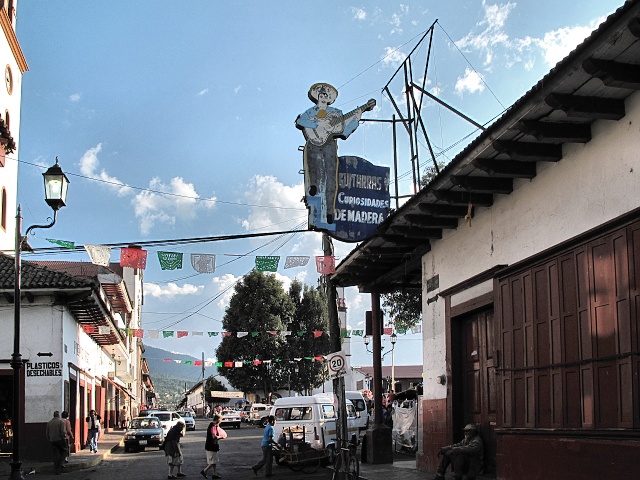
[Paracho] The town is famous for the manufacture of quality stringed instruments, mainly guitars
Restaurant
Sometimes I got fed up with street stalls and wanted to eat in a decent environment and use cutlery. That was not so easy. When I came across such a restaurant, it mostly did not meet my criteria – it was empty, with no one inside. But really there were not many of them, even though they were inexpensive (food and beer for about 100 pesos). Apparently the locals could not afford them and preferred to eat at the street stalls for a quarter of the price (but without beer). At the market in Paracho I saw a different type of food – butchers were selling cooked meat by weight (190 pesos per kg). They chucked a piece of meat on to a paper and an old lady walked around, selling tortillas to go with it. People stuffed themselves like mad. The grease was running down their chins, so I left. I finally stopped at the most crowded stall selling tacos on the square and I must say they were delicious. I had 4 of them and was satiated for 2 USD. But one did not have to bother about the fact that, under normal operations, the meal was served on a plate wrapped in a plastic bag. When one customer finished eating, only the plastic bag was replaced and the next customer ate from the same plate, without it having been washed at all.
Celebrations in Uruapan
Uruapan owes its existence to the Cupatitzio River, along which arises an oasis of lush tropical vegetation. The Indian name Uruapan means “Eternal Spring”. The surrounding area is extremely favorable for avocado, this very healthy and nutritious fruit growing on trees that have produced two crops per year for the past 200 years. Only 5 percent is exported from Mexico, the rest is consumed there. The popular Guacamole sauce, which is widely used in Mexican cuisine, is produced from avocados.
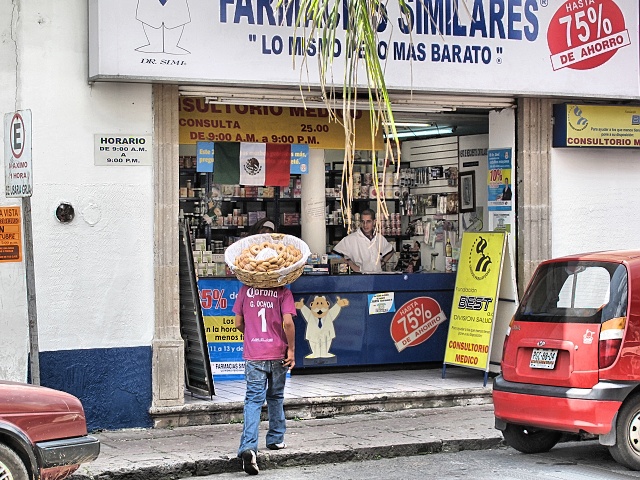
[Uruapan] An unusual way to carry bread
On arrival in the town, I was welcomed by volleys of cannon fire, a brass band was playing on the square, politicians were speaking from a podium. I had timed it perfectly, the town was celebrating its greatest holiday – the Day of St. Francis – its patron saint. I could not miss it. So after 35 kilometers, I stopped cycling. I went to see the Barranca del Cupatitzio National Park, which is just one kilometer from the town square. It is situated along the river and is a combination of natural waterfalls and artificial fountains, bridges and footpaths, amidst wild tropical vegetation.
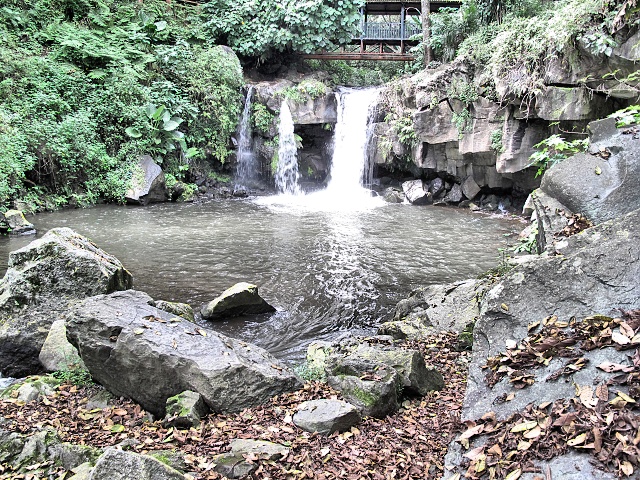
[Uruapan] National Park Barranca del Cupatitzio - one of the natural waterfalls
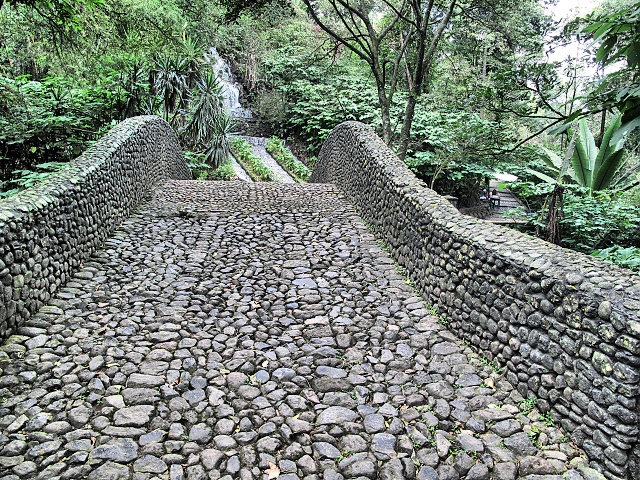
[Uruapan] National Park Barranca del Cupatitzio - stone bridge over the Cupatitzio River
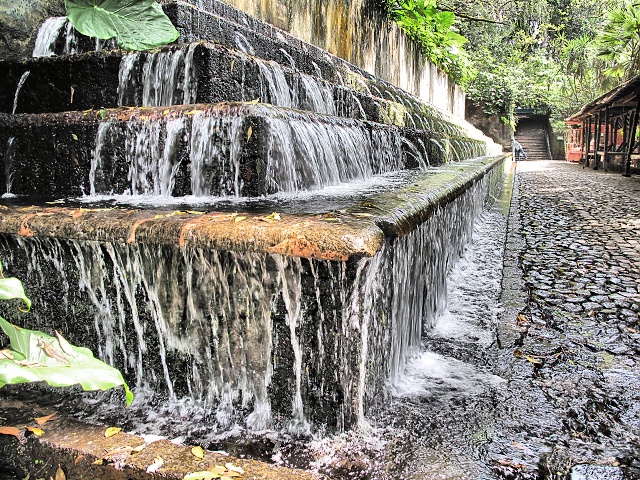
[Uruapan] National Park Barranca del Cupatitzio - fountain
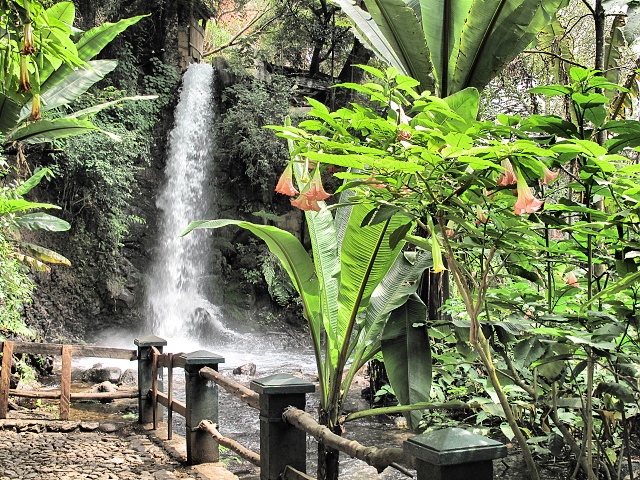
[Uruapan] National Park Barranca del Cupatitzio - another beautiful waterfall amidst beautiful greenery
The weather did not favor the celebrations. As soon as the procession had left the church, it started to pour with rain. However, neither the actors nor the audience were discouraged. The procession consisted of a number of costumed groups, each with its own brass band. The actors danced through the two-hour procession, even though among them there were a lot of elderly people. It should be noted that the music—two drums and trumpets, trombones and the obligatory sousaphone (bombardon)—was a powerful drug. They spiced it up so much that even my feet, although I am a determined non-dancer, began tapping by themselves (well, maybe it was the beer I had consumed as well). The overall atmosphere was buoyant, non-sectarian, although it was a religious procession. A folk dancing performance lasting about two hours followed in the evening, where the same actors demonstrated sophisticated dances on the theme of the sowing and harvesting of crops, courtship and similar images from life. One of the groups had a retarded young man among its members. Although he rather spoiled the show, he was obviously so enjoying himself, that it was a joy to watch. And when the leader of the group praised him backstage, he was in seventh heaven. The highlight of the program was the fireworks' display. These were not like the fireworks we are accustomed to in our country, but a real Mexican visual religious fireworks' display. The guys had been preparing it from the morning, then it had rained, but they somehow succeeded in carrying it through. They had built a structure of about 12 meters in height, from which many wires led, which, in the course of the production, the men gradually connected to a battery and thus launched the individual effects. One guy rotated the structure manually and, in addition to the rockets and firecrackers, inscriptions appeared in the fireworks, such as “God I love you” and similar texts, which circled through the air and slowly floated to the ground and burst. Behind the audience were strategically placed pipes with powerful rockets and bangers, loud explosions, beautiful patterns in the sky. All this took place on a small patch in the middle of the square, pieces of burnt missiles were falling among the audience. In our country, the security authorities would have gone crazy about it. But it was an unforgettable spectacle.
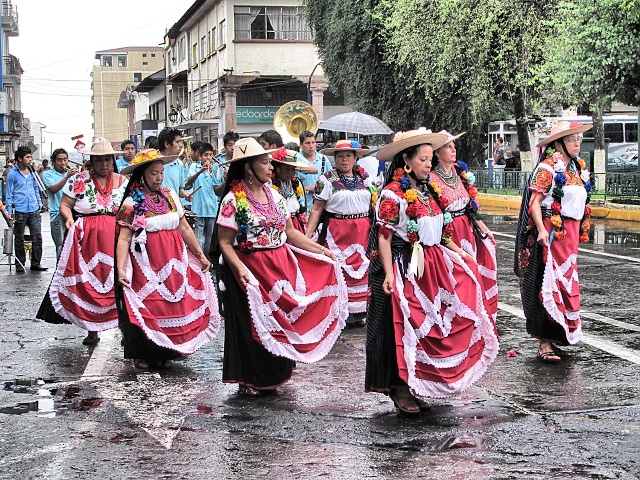
[Uruapan] Procession to mark Dia de San Francisco - the girls were not the youngest, but danced for hours, as if obsessed
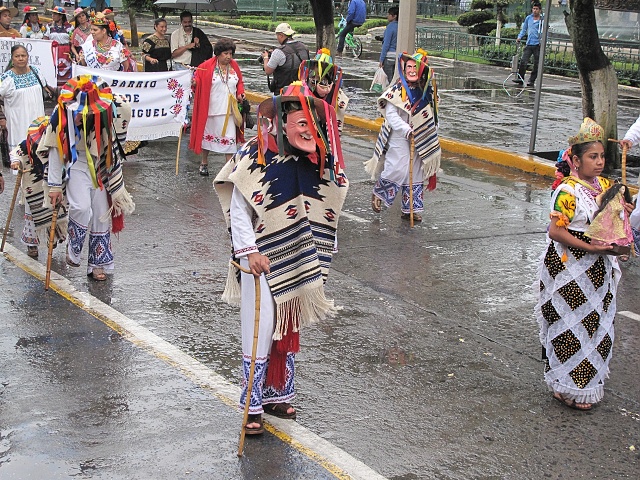
[Uruapan] Procession to mark Dia de San Francisco - characters with sticks performed a strangely goofy dance, a joy to watch
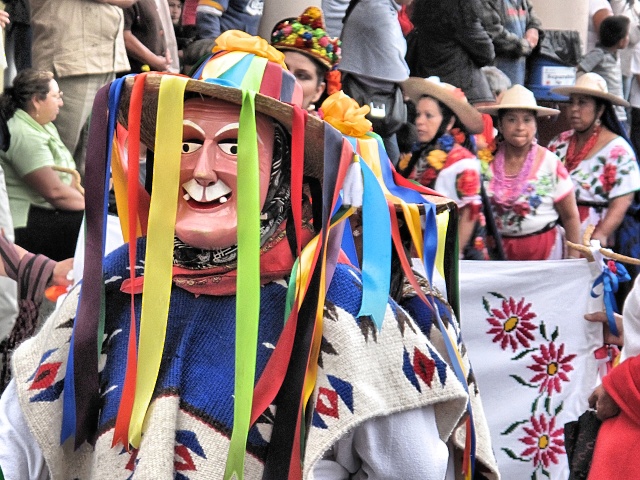
[Uruapan] Procession to mark Dia de San Francisco – crazy masked dancer
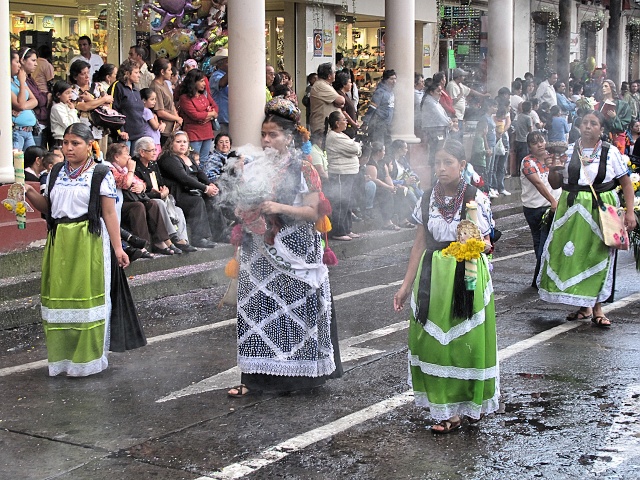
[Uruapan] Procession to mark Dia de San Francisco – frankincense was not absent
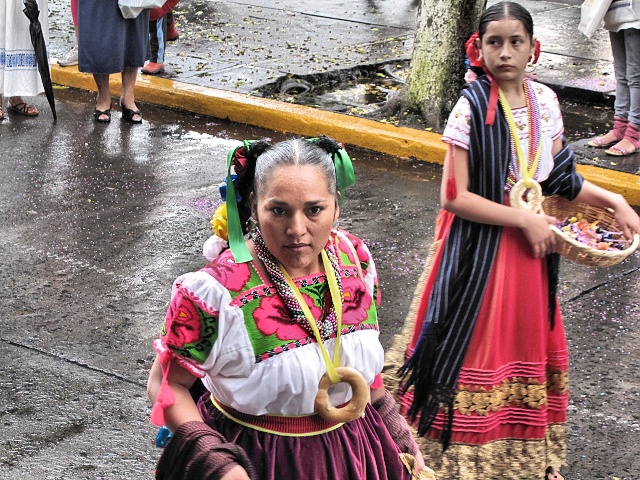
[Uruapan] Procession to mark Dia de San Francisco – a pretzel around the neck was one of the symbols of the celebration
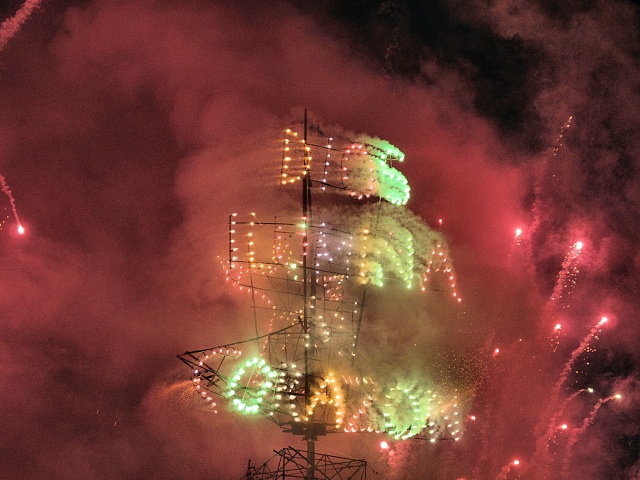
[Uruapan] Procession to mark Dia de San Francisco – fireworks even made impressive advertising signs – translate it for yourself
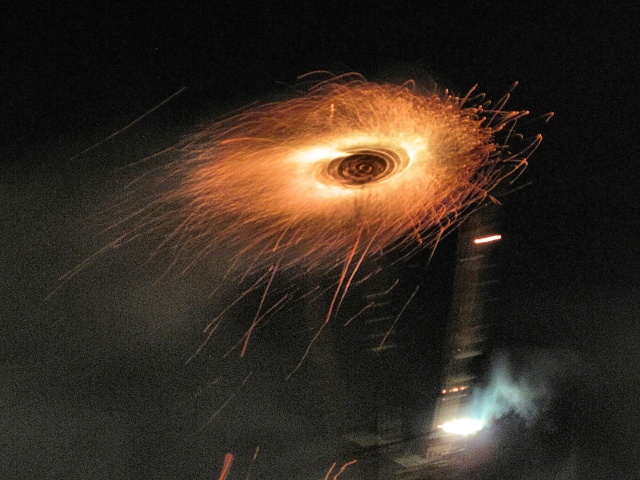
[Uruapan] Procession to mark Dia de San Francisco - one of the wild creations of the fireworks
A Slow Start
Still filled with the impressions of the previous day’s celebrations, I slowly began to pedal up the altitude lost by the last big descent, with new experiences awaiting me. Beyond Tingambato village is an archeological site, where I saw my first Mexican pyramid. To save me from shock, its height was only 9 meters, but even this was very impressive. In addition to the Moon Pyramid, there are also foundations of two palaces with altars and a vast pelota court. Everything dates back to 600 AD. Due to the remoteness of the site, not many people visit it. I was there alone, so could enjoy it perfectly. I learnt from the Visitors' Book that there were usually only one or two visits per day. There is an avocado orchard on the site, so I picked two for myself. The fruit on the tree is as hard as a rock, it only begins to soften after picking.

[Tingambato] Archaeological site - building from 600 AD, altar in the center
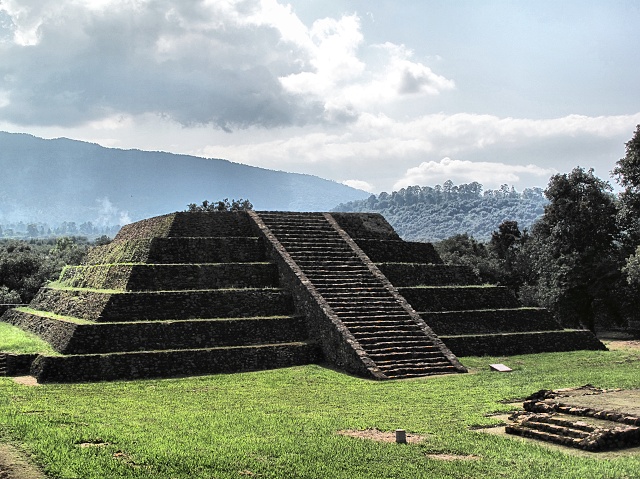
[Tingambato] Archaeological site – The Moon Pyramid is 9 meters high, good for a start
Pátzcuaro
This is situated near the lake of the same name. I therefore first cycled to the dock from where boats take passengers to the island of Janitzio. The cemetery on the island is the most vital attraction on All Souls’ Day. Just to go there, you need to arrive at the cemetery as early as 3 a.m., otherwise it is hopelessly packed to bursting with people. Only those who are buried there do not have to hurry. In the harbor, there were a lot of pubs of the cocina económica, comida corrida type (good, cheap restaurants with a limited repertoire, mastered superbly, however, by female cooks). I was hungry. En route, I had eaten only cucumber and tomatoes, as I had an extremely sensitive nose. I sensed the aroma of roast fish, followed the trace and had a plate of the smallest fried fish, a rare delicacy.

[Lake Pátzuaro] The overgrown harbor, with boats appearing to have docked on the grass
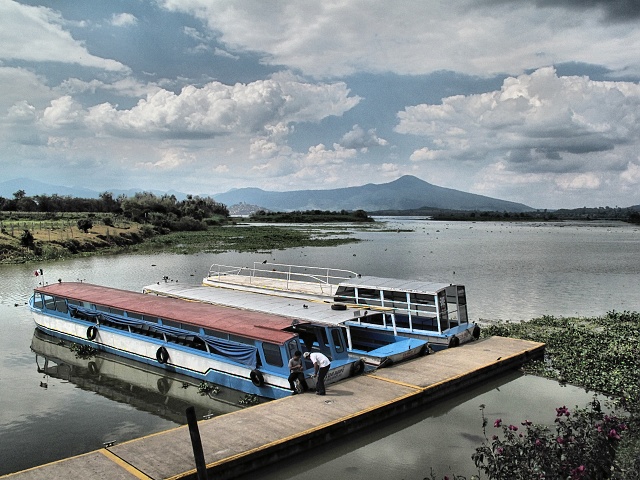
[Lake Pátzuaro] The second harbor, Janitzio Island, can be guessed at in the center of the photo
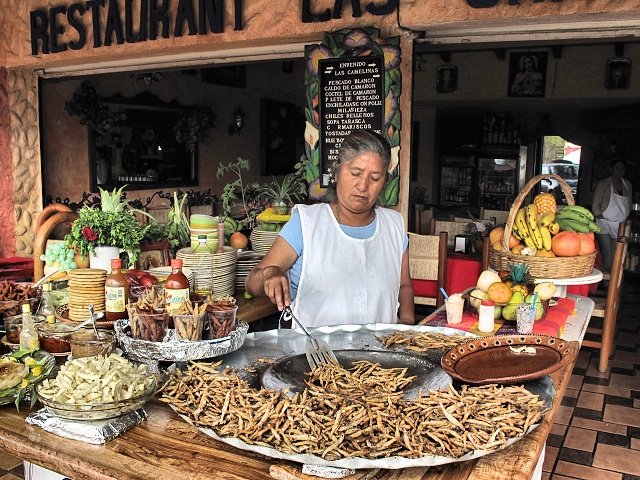
[Lake Pátzuaro] The cook fried small fish for me – it was a treat
The historical city center is pure magic. Two squares, Plaza Grande and Plaza Chica (i.e. large and small squares) are surrounded by arcades, many churches and palaces, houses plastered in a uniform color. The colors of the doors, frames and shutters are equally uniform, with the same style of lettering above the stores. Nevertheless, it is all within a relatively small and compact space, which enhances the effect even more. Fine, but I was hungry. I went off in the direction of a restaurant, but passed the stalls on the small square, where they were serving incredible portions – a piece of chicken, five enchiladas, lots of vegetables, potatoes and side dishes. So I thought, "I can fill myself with this!" I ordered and subsequently discovered that the servings were for two persons. Never mind, I would finish it! Bravely, I devoured it, it was very good. Some people at the table were staring at me. The barriers were broken when, after half a spicy jalapeno, I hiccupped loudly. We started talking, these people were from Tijuana and I told them of my journey through Baja. They had arrived by car on the mainland. Nope, I did not finish the meal, it was really an enormous portion.
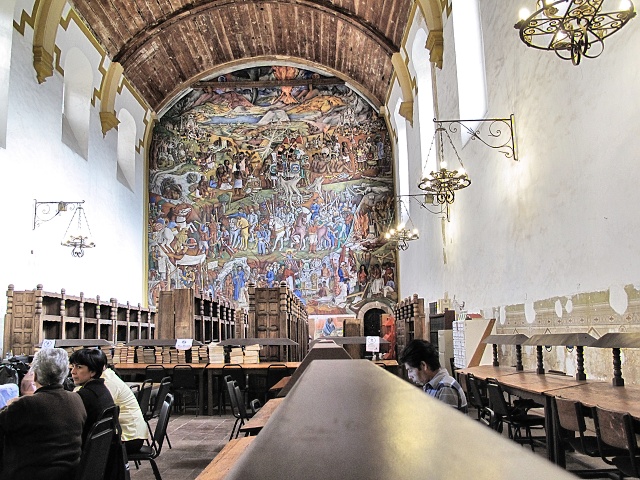
[Patzuáro] The local public library was originally a church
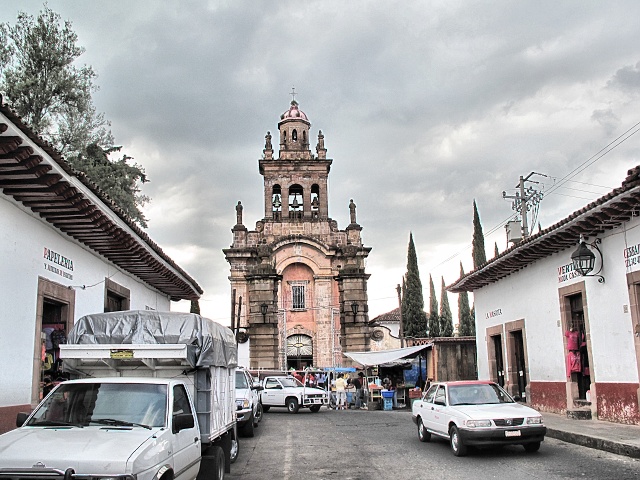
[Patzuáro] Templo El Santuário
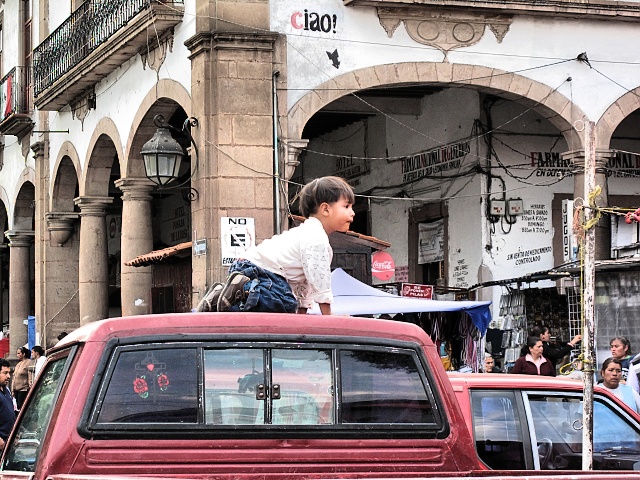
[Patzuáro] Plaza Chica (small square) – a child playing on the roof of the family car
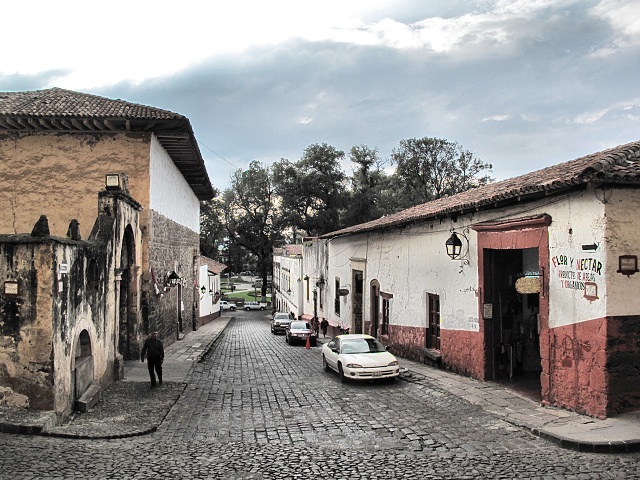
[Patzuáro] Streets in the historical center are of a uniform color, all inscriptions on stores are in the same font, the first letter is red, the rest are black
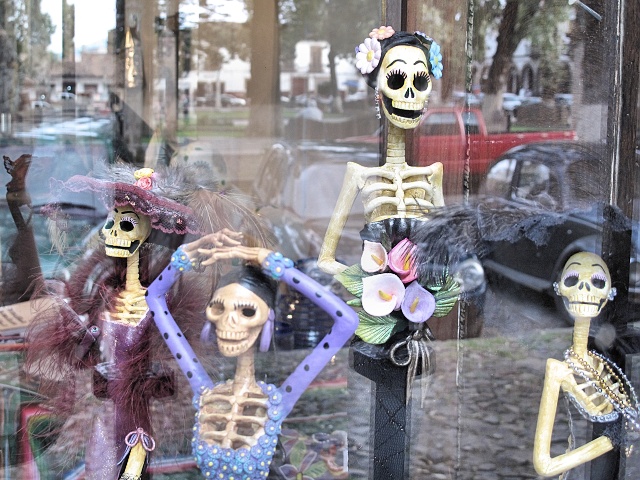
[Patzuáro] The girls are looking forward to their stellar moment that comes once a year on Día del Muertos (Day of the Dead, our All Souls’ Day)
Morelia
I could not find a map on which the altitudes were marked. Although I knew that Morelia is about 300 meters below Pátzuaro, I did not expect a steady downhill road. Which was also confirmed, as I first had to pedal up to a nice altitude of 2,400 meters, and only then sail nicely downhill. At first it was easy, around the lake with a slight super-elevation up to Tzintzuntzan, where I studied the excavations in the substantial Tarascan Fortress above the city. Then for an hour I dealt with the speed sensor on the cyclocomputer. And then over the mountains and valleys in the afternoon peak-hour traffic, I battled on to Morelia, a city of 650,000 inhabitants. In 1991, the center was declared a UNESCO World Heritage Site. So I took a one-day break to see everything thoroughly. And I also needed to wash and gather my strength before the first real mountain stage of the 2,900-meter pass.
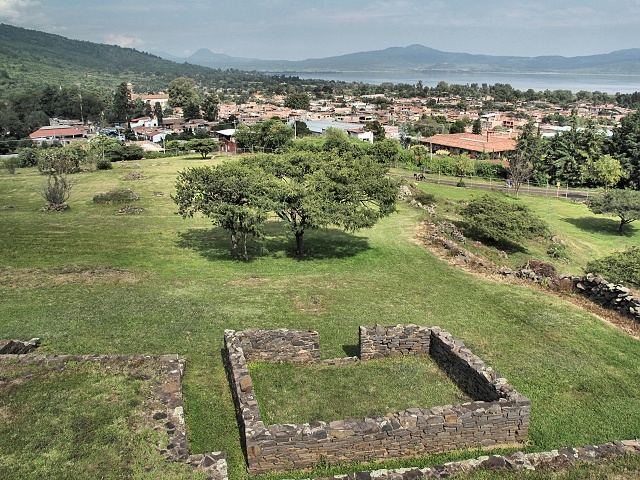
[Tzintzuntzan] Archaeological excavations are above the city, with a view of Lake Patzuáro
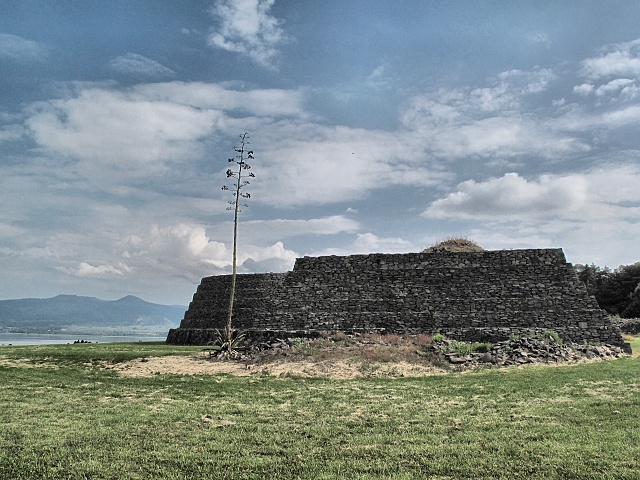
[Tzintzuntzan] The ruins once were the capital of the Tarasks, who defeated the Aztecs in the 15th century
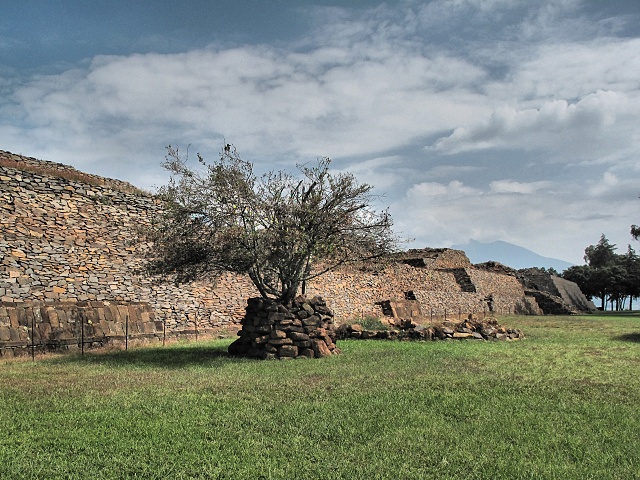
[Tzintzuntzan] The ruins show how huge this fortified residence was
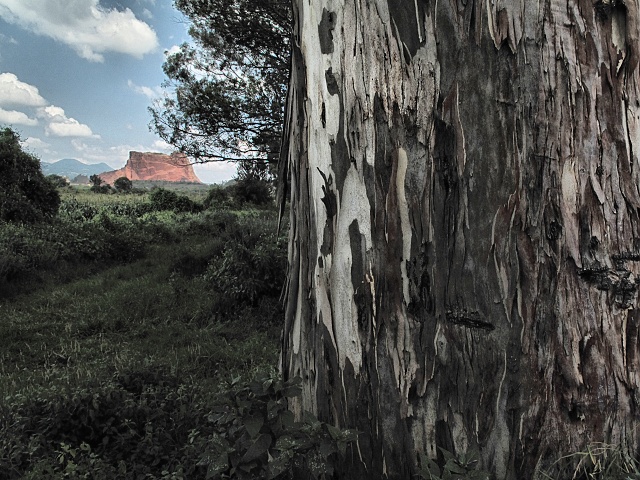
[Near Morelia] Landscape with a tree
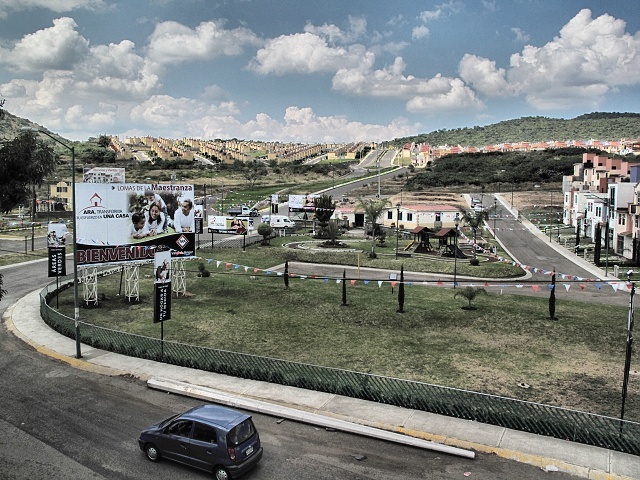
[Near Morelia] Morelia is surrounded by housing estates consisting of similar houses
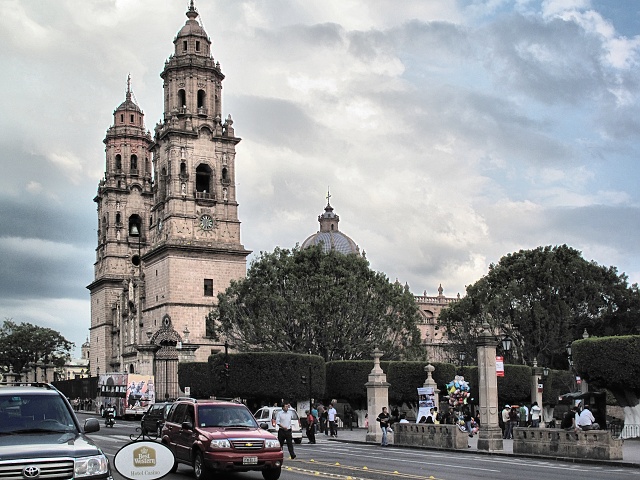
[Morelia] The Cathedral is the biggest attraction, of course
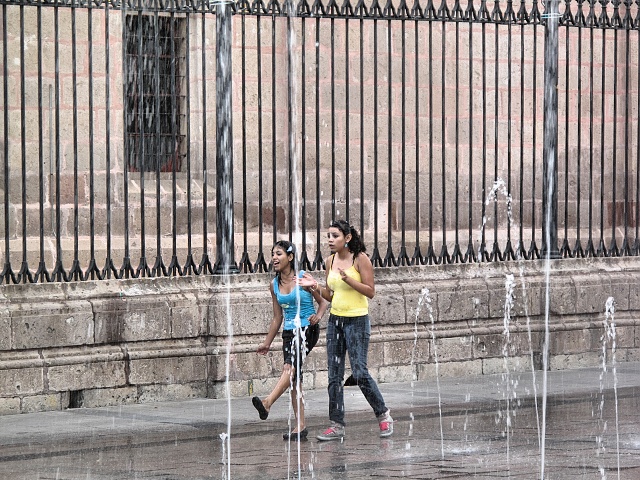
[Morelia] Teenage girls showing off at the fountain, and the boys are still nowhere in sight
One day was too little, yet Morelia left me with numerous impressions. I visited all the significant churches and palaces. Palaces usually serve as governmental buildings, so you have to get used to seeing policemen armed with automatic guns standing at the entrance. Which does not mean you cannot enter. Inside are murals of relatively recent dates, created approximately 20 years ago. Some are impressive, some seemed amateurish and terrible, but I am reproducing only the better ones. I also went through several museums and exhibition halls. I took photos with a tripod of the church interiors. Apart from some exceptions, I will not bother you with them, although they were most impressive in reality. The problem was that Mass was almost continuously being celebrated in the churches and I did not want to disturb people by photographing at the same time. But the Mass is spectacular, always celebrated by several priests in beautifully decorated vestments, the organs producing powerful tones, the whole assembly singing—truly beautiful, even for an atheist. I begin to understand what effect it must have had on the original inhabitants (speaking politically correctly) in times of the Spanish conquest.
Practical issues – in the morning I took all my clothes to the laundry (this time without the flash drive) and for a reasonable 45 pesos got them back dry and sweet-smelling in the afternoon. The tariff is based on the weight. In the neighborhood, there was also an “American” self-service laundromat, but I would have had to sit there for more than one hour and the price would have been double. During the day, several people stopped me, wanting to chat in English. The best of these was a shoeshine man who had lived in the US for 35 years and had returned home in his old age. We spoke for quite a while about various things, while he meanwhile cleaned and shone the Cossack boots of two middle-aged women. This is very atypical, mostly only men sit down at the shoeshine boys. He explained to me that he was a specialist in high boots and the city women only came to him.
In the evening there were festivities to celebrate the beginning of the century. Most of the buildings are about 130 years old. The police closed the center, causing incredible traffic jams. The city is clogged with cars even when everything functions, so this was a real breakdown. In front of the Cathedral, there was a podium for the elite, while the plebs did not have much chance of seeing anything. However, it was actually pretty boring—costumed people walking around the park, playing live music. Finally, there was, of course, the fireworks' display, but in a civilized form, nothing as primitive as I had seen in Uruapan. But still, the explosions were so loud that the horses participating in the parade took fright and the coachmen had to struggle to keep them under control.
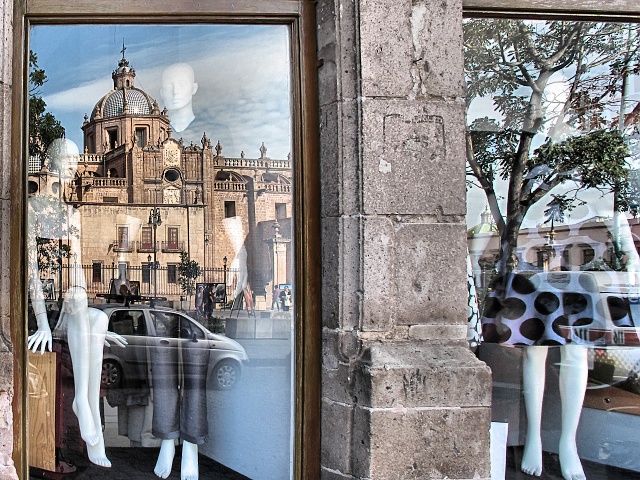
[Morelia] The Cathedral is surrounded by a number of expensive stores, especially fashion stores
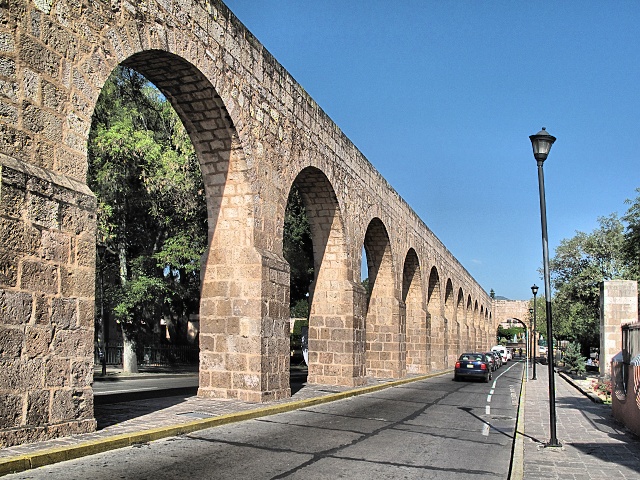
[Morelia] The aqueduct, several kilometers in length, is one of the town's attractions
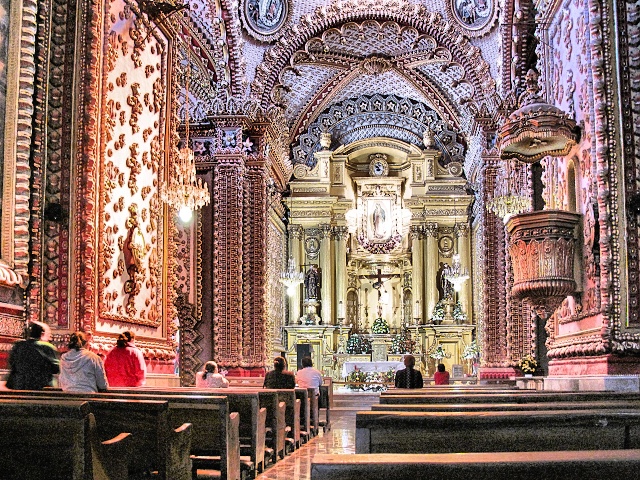
[Morelia] The decor of the Santuario de Guadalupe Church is like a psychedelic dream
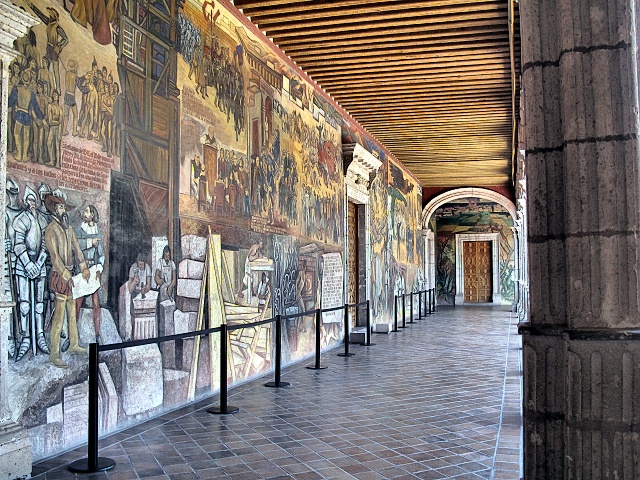
[Morelia] Palacio de Gobierno serves as one of the administrative buildings of the State of Michoacán, it is freely accessible; the fresco by Alfredo Zalce naturally depicts incidents in the struggle for Mexican independence

[Morelia] The University Library is housed in a former church
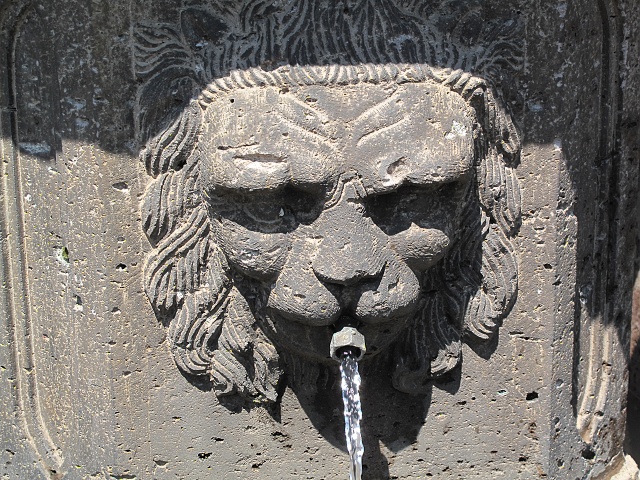
[Morelia] Fountain detail
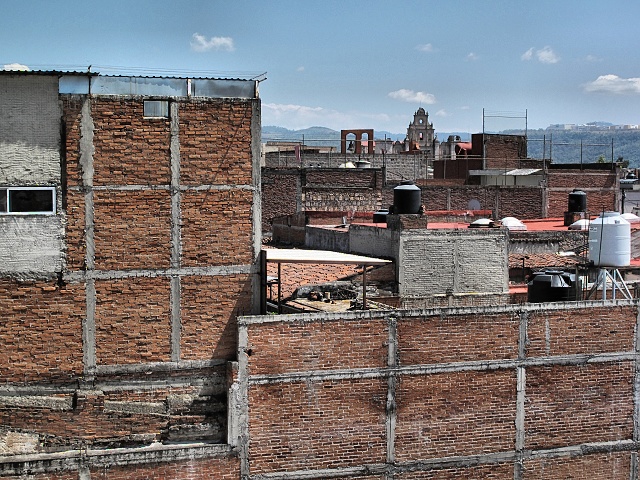
[Morelia] The interior view is not as glowing as the view from the main boulevards
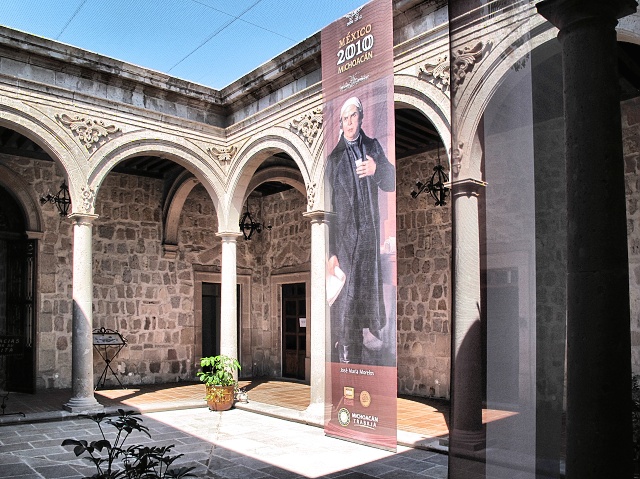
[Morelia] Birthplace of an outstanding independence fighter, after whom the town is named - José María Morelos y Pavón - depicted on the banner, with his head swathed in a typical scarf
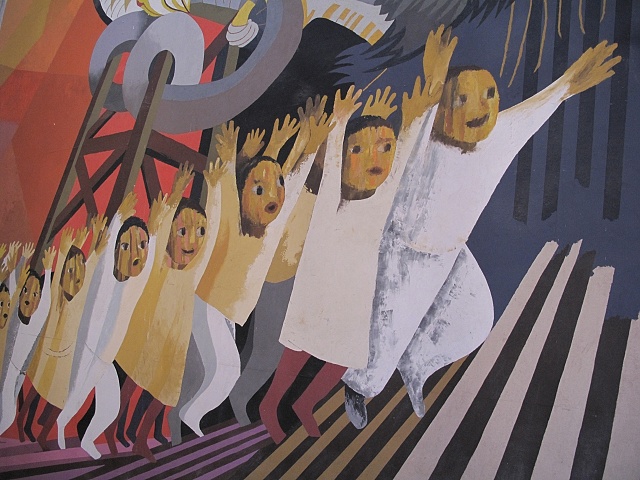
[Morelia] Colegio de San Nicolás de Hidalgo - now serving as a university - detail of wall fresco
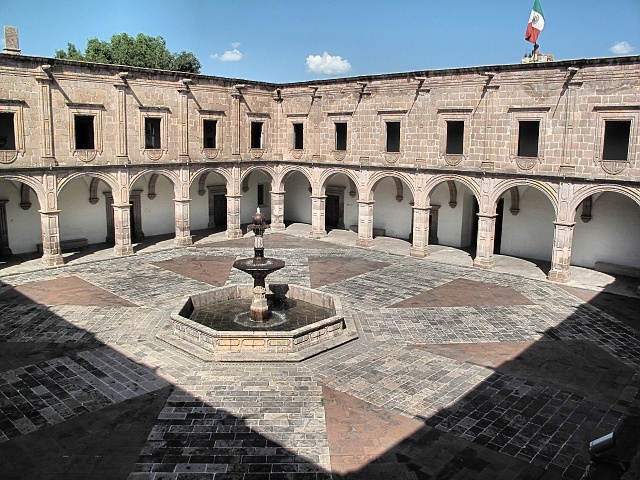
[Morelia] Palacio Clavier, now an exhibition hall; there were several exhibits by various artists
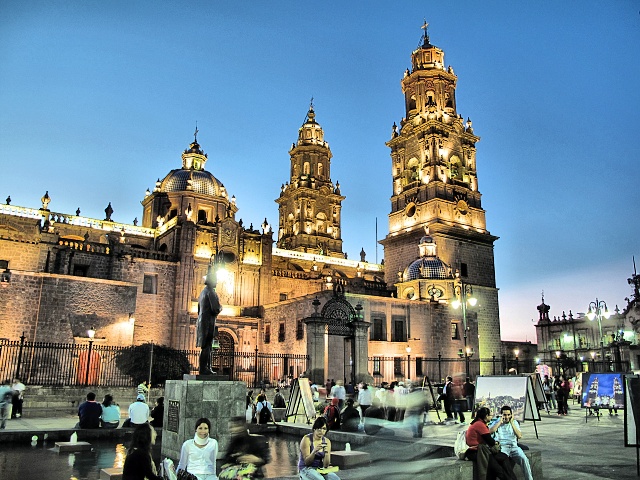
[Morelia] The Cathedral is most beautiful at dusk
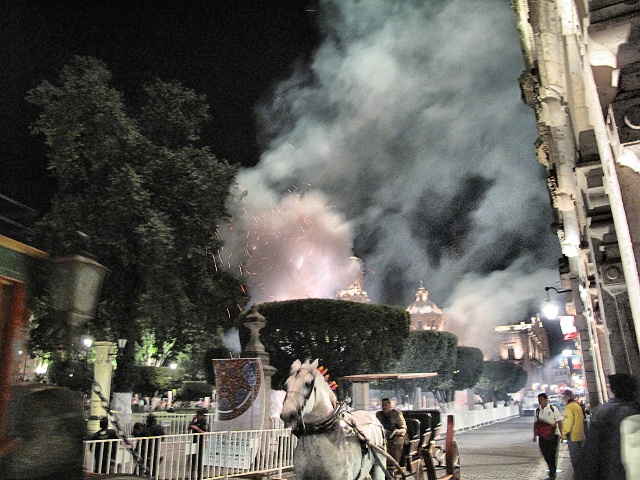
[Morelia] Plaza de Armas – the fireworks scared the horse pulling the carriage
Struggle with the Cyclocomputer
The data transfer from cyclocomputer to PC is infrared, so I have an IrDA USB adapter and it usually works without any problem. However, in Pátzcuaro I could not download any data. I inserted the IrDA USB adapter into another USB slot several times. I restarted the computer, all to no avail. Finally, it occurred to me that the problem might be caused by the glass table top on which I had the computer. I put a towel on the table and lo and behold, the download started running successfully! But this did not end the problems. On the next day as I was leaving Tzintzuntzan, I noticed that my speedometer was not indicating anything. Well, I know, I thought, and pulled out a new speed sensor. Sensors have a non-removable battery, so of course their time is limited, unfortunately they do not indicate it in advance. But the last time I had changed the speed sensor was in Australia two years before, so it was entitled to break down. I cut off the sensor from the plug and assembled the new one with tightening tape. I ran the scanning mode which finds the new sensor, wirelessly connects to it and sets up an encrypted connection. Everything was OK, but the speed was still zero. Well it would be really be no fun for me if I did not know how fast I was cycling. I removed all the bags, tuned the position of the sensor for an hour, even changed the magnet on the wheel spokes, still nothing. I launched the scanning mode at least five times. Finally it seemed that everything was functioning OK. Uh, uh.
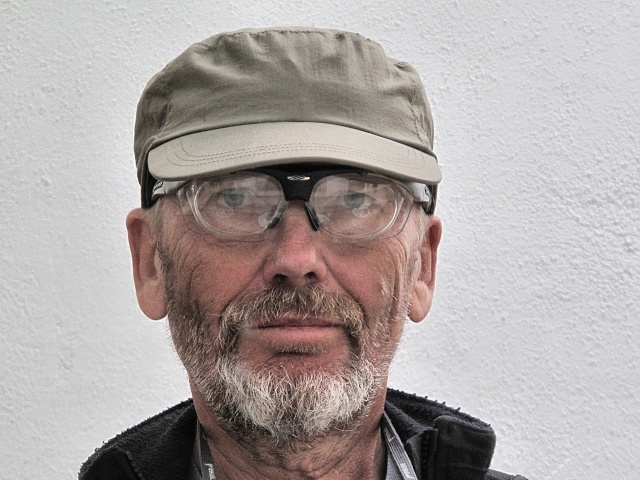
[Morelia] My current civilian (i.e. non-cycling) appearance
Missed Mountain Pass Record
And I was facing the ultimate challenge. I knew that I had to go through the Paso de Mil Cumbres mountain pass at an altitude of 2,886 meters above sea level. Given that my previous altitude record on a bike was less than 1,900 meters, when I had cycled from San Francisco to the Yosemite National Park, I was really curious. I particularly expected breathing problems, after all, my body was already physically “used up” and so I really did not know what it would do. From Morelia it was basically a 60-kilometer climb. According to my information from the Internet, the highest altitude of the pass would be at the 67th kilometer. I planned that, at the highest point, I would photograph myself to record my new altitude record. I had almost reached the altitude, but I was not even at the 60th kilometer, when the road began to descend. So I cycled downhill, knowing that I would have to work my difficult way up again later. But I never worry about this, that’s life, and what I cannot influence I do not grieve over. When I had descended to an altitude of 2,500 meters, I realized that I had actually already gone over the pass! The highest point was not indicated there in any way, so I missed it and so you will not be able to enjoy the photo of a sweaty and hard-breathing cyclist proudly looking into the camera and patting his own back that he has done it again! Actually, I did not have any breathing problems, I felt more pressure in the abdomen, but it was from hunger, as was confirmed at the first suitable restaurant.
After more than 100 kilometers, I stopped in Ciudad Hidalgo, a town so sightless and ugly, that it did not motivate me to take a single photo there.
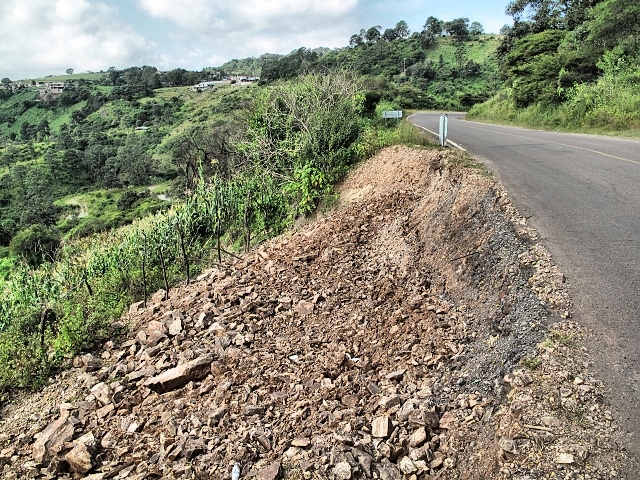
[Near Morelia] The verge of the mountain road was sometimes worn away, I had to be on my guard
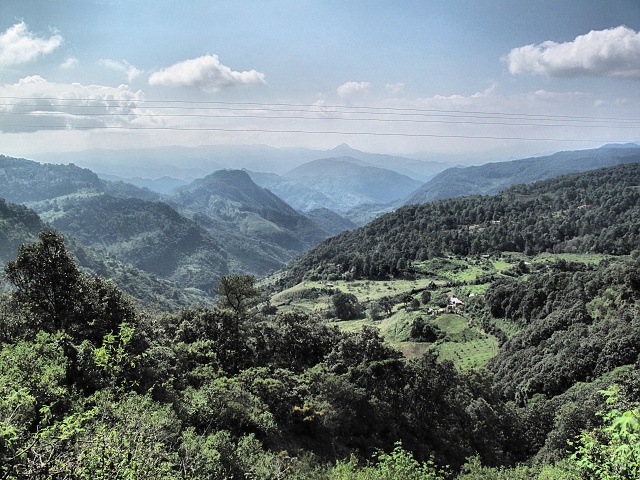
[Near Morelia] Views of the countryside were worth the effort
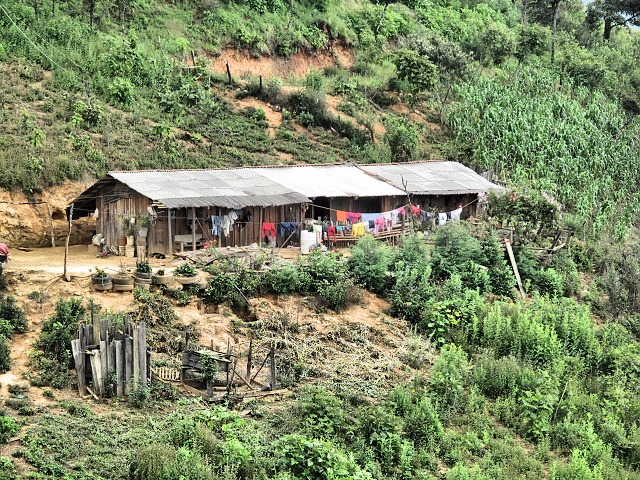
[NP Cerro de Guernica] Lonely mountain building, life here is no bed of roses

[NP Cerro de Guernica] The entrance to the church in a mountain village
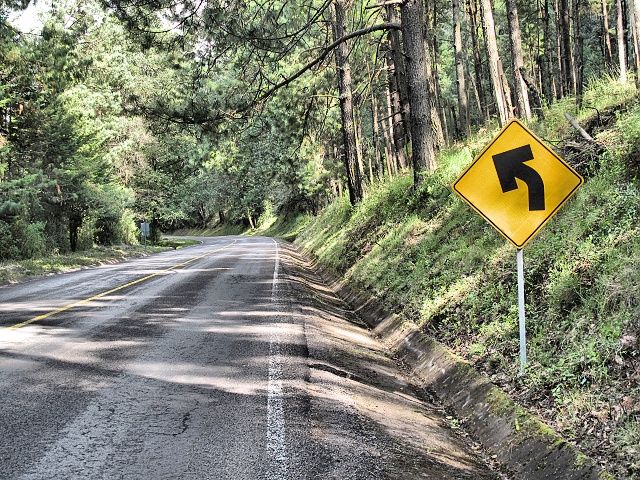
[Road 15 near Huajúmbaro] Cycling was amazing, fresh forest air, minimal traffic and many bends
More Hills
The next day, cycling was comfortable up to Zitácuaro, where the road began to rise steeply. The road split into paid and unpaid roads. A car stopped next to me and the driver began to try to convince me vehemently to take the paid one, otherwise it would be 30 kilometers of hard work over the hills. To my objection that bikes were not allowed on paid roads, he generously waved his hand and said that the roads would reconnect again. So I went back about one kilometer to get on to the paid road, but was uncompromisingly turned back on to the unpaid one. However, I did not complain. The unpaid road meandered through several villages such as Mano de Agua, La Dieta, and because it was Saturday, guys with bottles of beer were sitting on the squares, shouting at me, “Hello, my friend” and “Olé, olé,” I answered “Buenas tardes amigos!" and we all were happy. I only sweated much more. At the highest point where the roads merged again, I had reached almost the same height as on the previous day. Then a wild descent on to a busy road with no shoulder, and finally, as a test of will, a few kilometers of climbing.
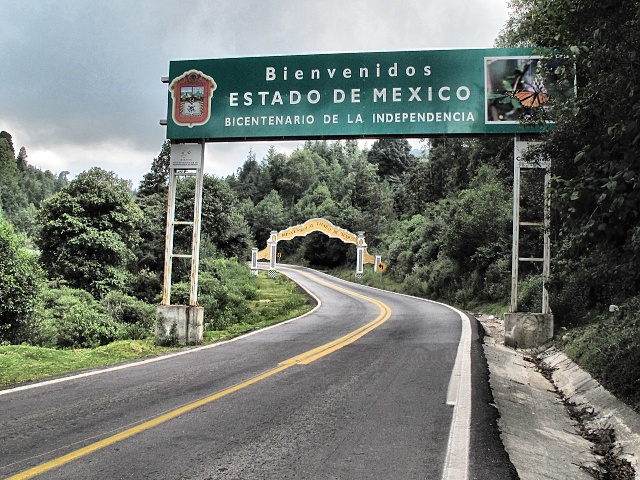
[Near Macho del Agua] Crossing the border from the State of Michoacan to the State of Mexico, which lies beyond the 1941 gate
Toluca
The morning mist was so dense that one could almost slice it. I turned on the flashing light, but most importantly, the road had a verge of about a meter in width, with a satisfactory and tidy surface, an unprecedented thing in Mexico. Together with that tidiness, it was not so hot. Sometimes I passed by a run-down dog in various stages of decomposition on the verge. Often it was in the middle of the village, the dog had to lie there and stink for a few weeks, but no one bothered to remove it. My arrival in Toluca, a city of half a million, was problem-free. Only near the center there were crowds with flags, cops diverting the traffic. I thought it was a strike, but there were stalls everywhere. So I found some accommodation in the center and went out to look at the city. The cause was a football match, policemen on horses, soldiers with shields and dogs securing the situation, a police helicopter flying above. The match ended after two hours. Some fans tried to riot, but those were few in number.
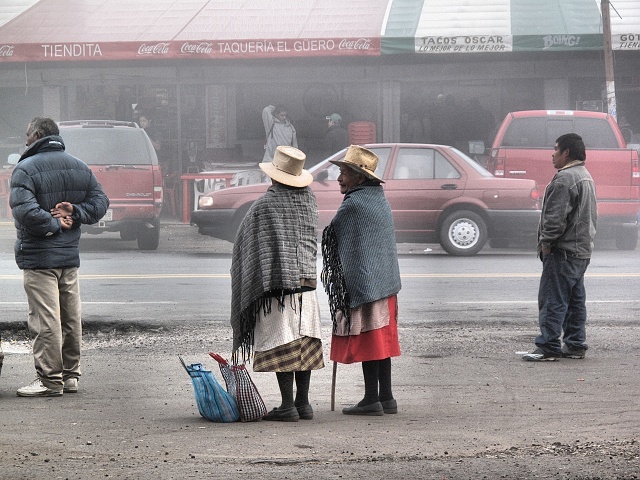
[Villa Victoria] Indian women waiting in the morning mist for the bus
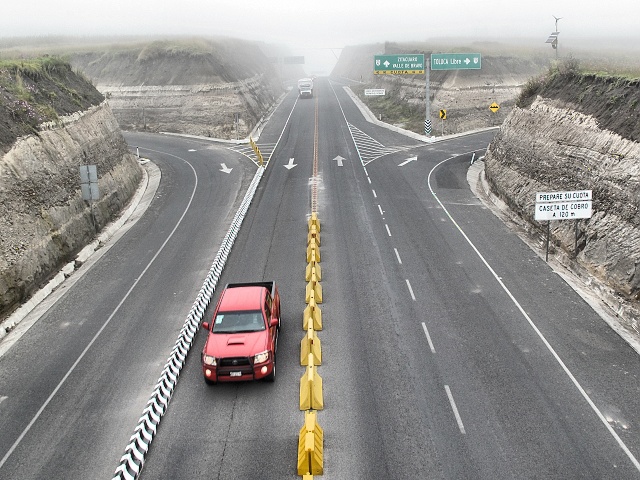
[Near Toluca] The morning fog could be cut with a knife, here at the intersection with the paid highway
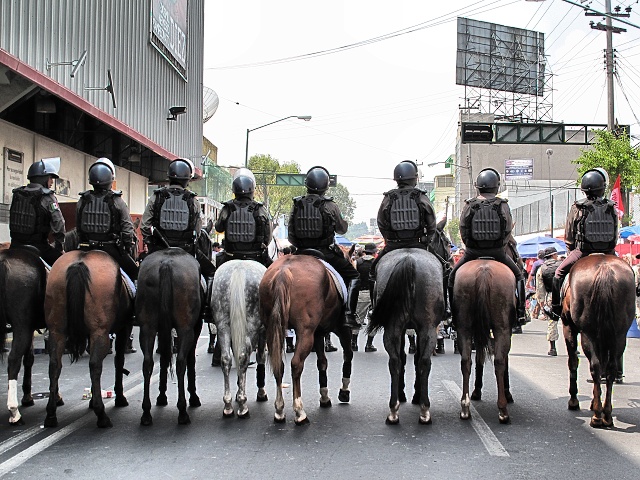
[Toluca] Mounted police guard the football match
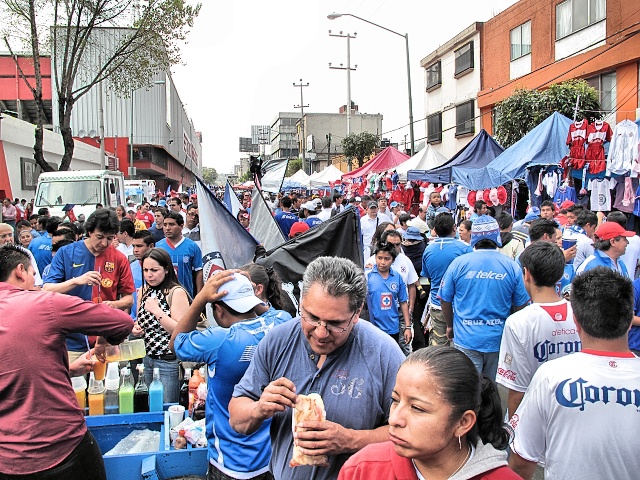
[Toluca] Most fans also had fun after the match, and of course stuffed themselves with something tastily unhealthy
The mass of people partly spilled over into Alameda Park, which was mainly filled with food stalls and many attractions for children. The program began on stage. Mexicans are great patriots, I acknowledge this, it is fine. So a speech first, then the anthem, then calling “Viva Mexico”, then a revolutionary song (some of you will certainly remember how, after our anthem, the Internationale was played). A good folk singer performed. Then the clowns, the highlight of their performance was throwing cheap gifts into the audience, the kids fought for them, so it was fun. Organizers distributed free sliced fruit to the seated audience. I got some too (they probably noticed how loudly I was yelling “Viva Mexico”). The highlight was a Rock band, so terrible that I left in the middle of the first song. And I did well, as a heavy downpour followed, but I was already in the center under the arcades and could enjoy my favorite Modelo Negro.
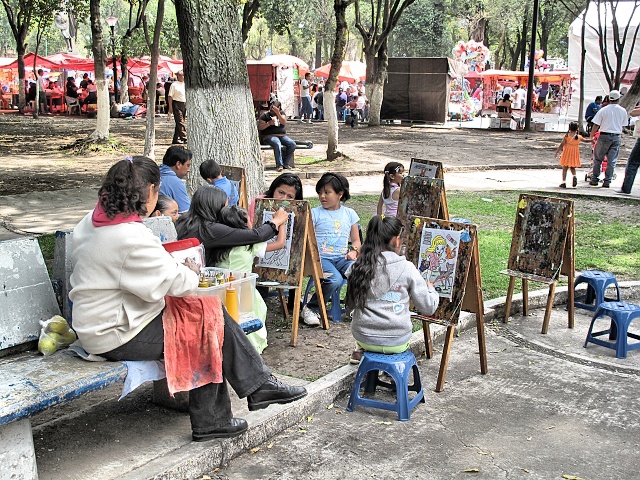
[Toluca] Alameda Park - a new successful business, renting easels and paints to children
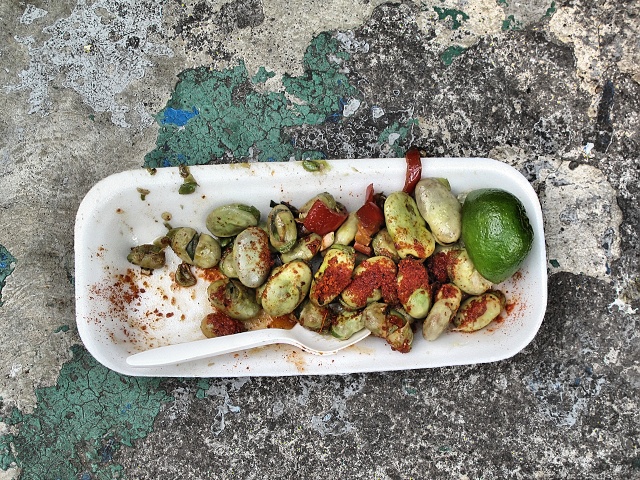
[Toluca] I had fried green beans, properly seasoned and delicious
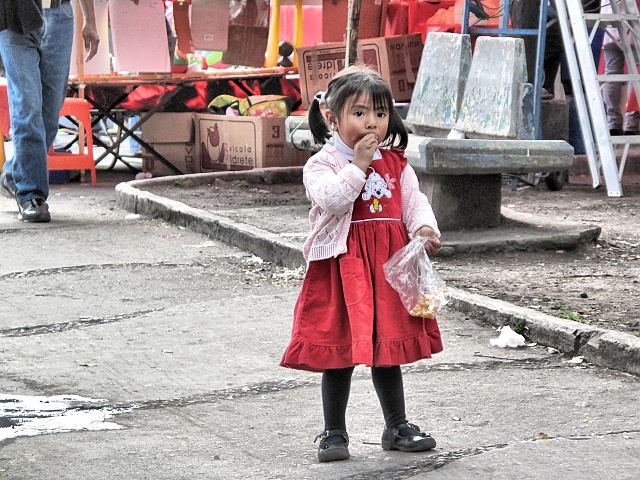
[Toluca] Everyone gorges, some even look cute doing it
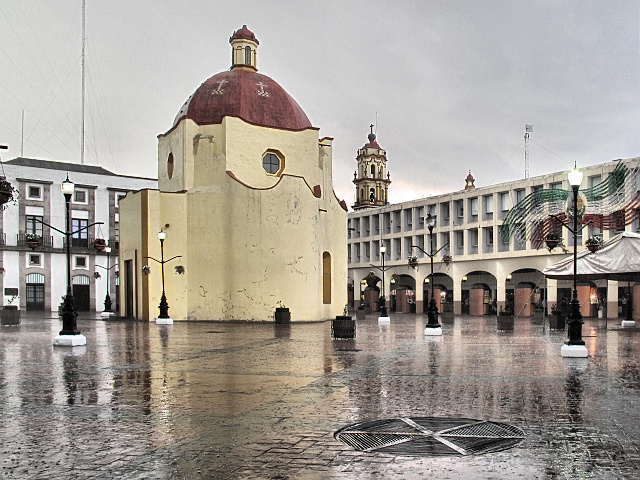
[Toluca] Center in the evening rain
Mexico City is the Capital of Mexico
In the morning, when I was hanging the bags on the bike, the mirror dropped off and was smashed to pieces. It was irreparable. Luckily, I had bought a good panoramic mirror in Morelia which could be inserted into the head-tube. I had it on the right side, so I just put it on the left side. In the rush hour that day, the mirror would be needed. I cycled on to the highway, which was relatively wide, although the verge was of poor quality. In this way, I stayed out of the way of the cars in the Monday morning rush hour. Then the road split into paid and unpaid, and I had reached the highest point thus far at 3,110 meters above sea level. Then it was downhill all the way to the center of Mexico. Again, this was a potent experience, the category of which is sufficient to go through just once a year. My speed was high, though the quality of the road changed significantly and abruptly. The worst was that the state of the roads varied. So, for example, I was suddenly in the middle of a five-lane highway and, at a speed of 50 kph, would be pleading by my gestures with drivers to let me move over to the verge. Drivers do not regard a bike as a proper vehicle that is to be overtaken, they try to keep in their lanes and those with poor judgment were at my elbows. Pros such as truck drivers are much better in this respect and know what a gust of wind from a truck can do to a bike.
Then a guy on a powerful BMW motorbike appeared next to me. He asked where I was from, where I was going, he said he saw how hazardous it was for me in such traffic, and said that he would protect me. He drove about three meters behind me on my left, so the cars were forced to overtake us properly. I was safe and sound and could fly downhill at 50 kph. About 5 kilometers later, he showed me the way to the center and said goodbye. Thanks, buddy! In the central area it was not so bad, there was even a cycle track. However, cars were parked on it so there was not sufficient space for cycling. I navigated to finally find a hotel selected by Lonely Planet, checked into accommodation there and went out to buy a liter of beer. Thereafter, I would be lazing around for a few days.
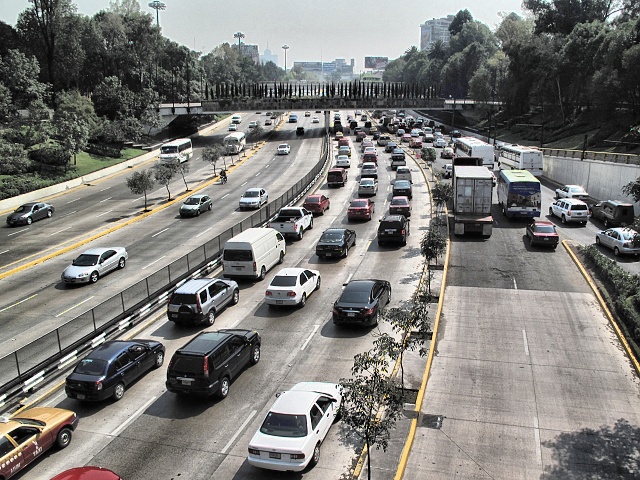
[Mexico City] Inner circle – the density of local traffic
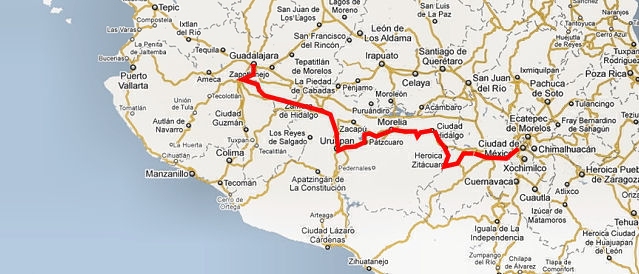
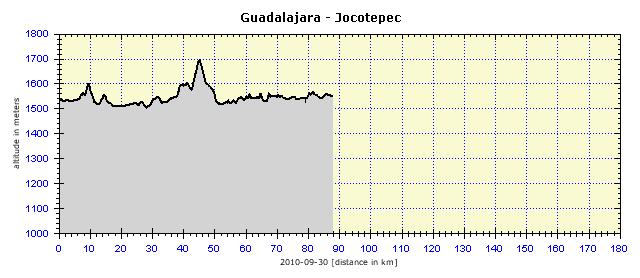

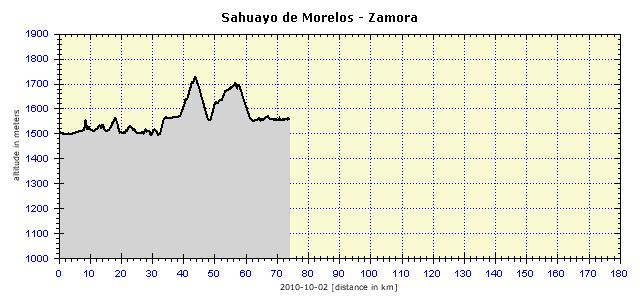
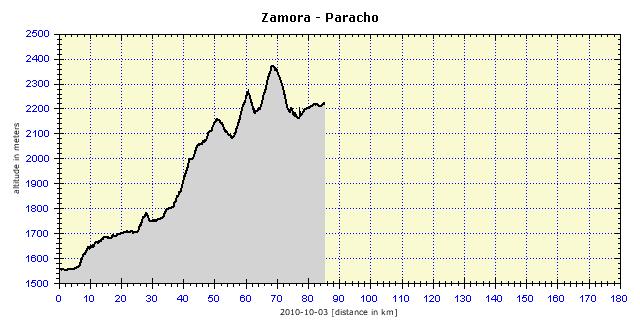
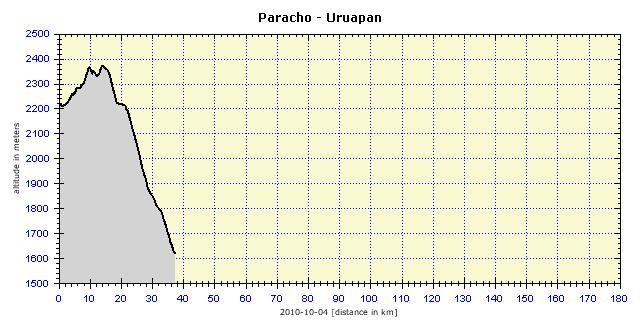
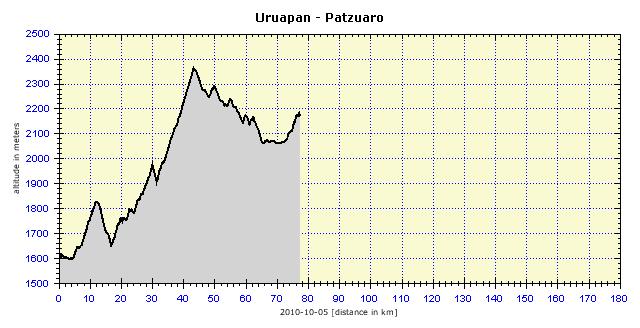
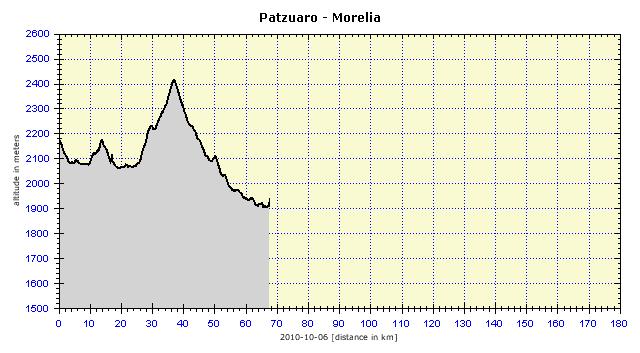
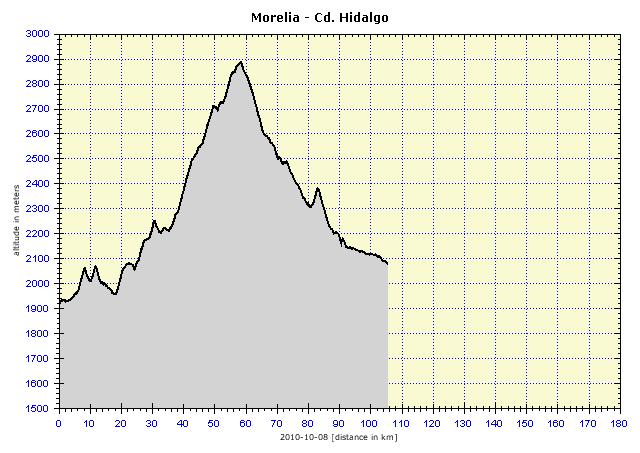
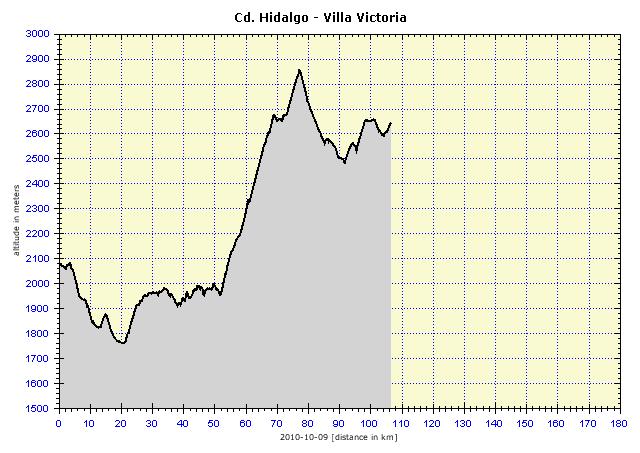


|




































































































